#c: qing kai ming
Explore tagged Tumblr posts
Text

an audibly shocked gasp hits the air, mischievous in nature. "the lady would believe me the destroyer of dreams and art." abdullah had no concept of right or wrong in general, not due to lack of education but simply because he was of the opinion that a world seen with duality was not a world he wished to be apart of. "i would not have offered if it was beyond my capabilities, i do have honour, after-all." he winks, a clear lie but one he doesn't speak on. "come, the flowers await."


she laughed at his joke, " ah, perhaps you're right ! i'm sorry, " the beauty played along, apologizing to the fabric. as he spoke about a private garden, kai-ming turned to look at him with excited eyes, " goodness, really ? that sounds wonderful ! " she exclaimed, " but . . i'm not staff and certainly not military. " the words were said with a frown. if this were back home, kai-ming would break the rules — but they weren't home, and she had to make the best impression on china she could. " could you take me there, to this courtyard ? " the princess asked hesitantly.
21 notes
·
View notes
Text
IEEE Transactions on Fuzzy Systems, Volume 33, Issue 1, January 2025
1) Guest Editorial Special Section on Fuzzy-Deep Neural Network Learning in Sentiment Analysis
Author(s): Gautam Srivastava, Chun-Wei Lin
Pages: 1 - 2
2) Fcdnet: Fuzzy Cognition-Based Dynamic Fusion Network for Multimodal Sentiment Analysis
Author(s): Shuai Liu, Zhe Luo, Weina Fu
Pages: 3 - 14
3) Joint Objective and Subjective Fuzziness Denoising for Multimodal Sentiment Analysis
Author(s): Xun Jiang, Xing Xu, Huimin Lu, Lianghua He, Heng Tao Shen
Pages: 15 - 27
4) Exploring Multimodal Multiscale Features for Sentiment Analysis Using Fuzzy-Deep Neural Network Learning
Author(s): Xin Wang, Jianhui Lyu, Byung-Gyu Kim, B. D. Parameshachari, Keqin Li, Qing Li
Pages: 28 - 42
5) Depression Detection From Social Media Posts Using Emotion Aware Encoders and Fuzzy Based Contrastive Networks
Author(s): Sunder Ali Khowaja, Lewis Nkenyereye, Parus Khuwaja, Hussam Al Hamadi, Kapal Dev
Pages: 43 - 53
6) EMSIN: Enhanced Multistream Interaction Network for Vehicle Trajectory Prediction
Author(s): Yilong Ren, Zhengxing Lan, Lingshan Liu, Haiyang Yu
Pages: 54 - 68
7) FICformer: A Multi-factor Fuzzy Bayesian Imputation Cross-former for Big Data-driven Agricultural Decision Support Systems
Author(s): Jianlei Kong, Xiaomeng Fan, Min Zuo, Wenjing Yan, Xuebo Jin
Pages: 69 - 81
8) ViTDFNN: A Vision Transformer Enabled Deep Fuzzy Neural Network for Detecting Sleep Apnea-Hypopnea Syndrome in the Internet of Medical Things
Author(s): Na Ying, Hongyu Li, Zhi Zhang, Yong Zhou, Huahua Chen, Meng Yang
Pages: 82 - 93
9) A Novel Centralized Federated Deep Fuzzy Neural Network with Multi-objectives Neural Architecture Search for Epistatic Detection
Author(s): Xiang Wu, Yong-Ting Zhang, Khin-Wee Lai, Ming-Zhao Yang, Ge-Lan Yang, Huan-Huan Wang
Pages: 94 - 107
10) A Comprehensive Adaptive Interpretable Takagi–Sugeno–Kang Fuzzy Classifier for Fatigue Driving Detection
Author(s): Dongrui Gao, Shihong Liu, Yingxian Gao, Pengrui Li, Haokai Zhang, Manqing Wang, Shen Yan, Lutao Wang, Yongqing Zhang
Pages: 108 - 119
11) A Temporal Multi-View Fuzzy Classifier for Fusion Identification on Epileptic Brain Network
Author(s): Zhengxin Xia, Wei Xue, Jia Zhai, Ta Zhou, Chong Su
Pages: 120 - 130
12) Structured Sparse Regularization-Based Deep Fuzzy Networks for RNA N6-Methyladenosine Sites Prediction
Author(s): Leyao Wang, Yuqing Qian, Hao Xie, Yijie Ding, Fei Guo
Pages: 131 - 144
13) Data-Driven Fuzzy Sliding Mode Observer-Based Control Strategy for Time-Varying Suspension System of 12/14 Bearingless SRM
Author(s): Ye Yuan, Kai Xie, Wen Ji, Yougang Sun, Fan Yang, Yu Nan
Pages: 145 - 155
14) Fusion of Explainable Deep Learning Features Using Fuzzy Integral in Computer Vision
Author(s): Yifan Wang, Witold Pedrycz, Hisao Ishibuchi, Jihua Zhu
Pages: 156 - 167
15) FMFN: A Fuzzy Multimodal Fusion Network for Emotion Recognition in Ensemble Conducting
Author(s): Xiao Han, Fuyang Chen, Junrong Ban
Pages: 168 - 179
16) MFVAE: A Multiscale Fuzzy Variational Autoencoder for Big Data-Based Fault Diagnosis in Gearbox
Author(s): He-xuan Hu, Yicheng Cai, Qing Meng, Han Cui, Qiang Hu, Ye Zhang
Pages: 180 - 191
17) A Dissimilarity Measure Powered Feature Weighted Fuzzy C-Means Algorithm for Gene Expression Data
Author(s): Ning Ma, Qinghua Hu, Kaijun Wu, Yubin Yuan
Pages: 192 - 202
18) End-Edge Collaborative Inference of Convolutional Fuzzy Neural Networks for Big Data-Driven Internet of Things
Author(s): Yuhao Hu, Xiaolong Xu, Li Duan, Muhammad Bilal, Qingyang Wang, Wanchun Dou
Pages: 203 - 217
19) A Hybrid Fuzzy C-Means Heuristic Approach for Two-Echelon Vehicle Routing With Simultaneous Pickup and Delivery of Multicommodity
Author(s): Heng Wang, Sihao Chen, Xiaoyi Yin, Lingxi Meng, Zhanwu Wang, Zhenfeng Wang
Pages: 218 - 230
20) Fuzzy-ViT: A Deep Neuro-Fuzzy System for Cross-Domain Transfer Learning From Large-Scale General Data to Medical Image
Author(s): Qiankun Li, Yimou Wang, Yani Zhang, Zhaoyu Zuo, Junxin Chen, Wei Wang
Pages: 231 - 241
21) Multiobjective Evolution of the Deep Fuzzy Rough Neural Network
Author(s): Jianwei Zhao, Dingjun Chang, Bin Cao, Xin Liu, Zhihan Lyu
Pages: 242 - 254
22) Boosting Robustness in Deep Neuro-Fuzzy Systems: Uncovering Vulnerabilities, Empirical Insights, and a Multiattack Defense Mechanism
Author(s): Jia Wang, Weilong Zhang, Zushu Huang, Jianqiang Li
Pages: 255 - 266
23) A Fuzzy-Operated Convolutional Autoencoder for Classification of Wearable Device-Collected Electrocardiogram
Author(s): Lumin Xing, Xin Li, Wenjian Liu, Xing Wang
Pages: 267 - 277
24) Quantum Fuzzy Federated Learning for Privacy Protection in Intelligent Information Processing
Author(s): Zhiguo Qu, Lailei Zhang, Prayag Tiwari
Pages: 278 - 289
25) Deep Spatio-Temporal Fuzzy Model for NDVI Forecasting
Author(s): Zhao Su, Jun Shen, Yu Sun, Rizhen Hu, Qingguo Zhou, Binbin Yong
Pages: 290 - 301
26) Composite Neuro-Fuzzy System-Guided Cross-Modal Zero-Sample Diagnostic Framework Using Multisource Heterogeneous Noncontact Sensing Data
Author(s): Sheng Li, Jinchen Ji, Ke Feng, Ke Zhang, Qing Ni, Yadong Xu
Pages: 302 - 313
27) Exploring Zadeh's General Type-2 Fuzzy Logic Systems for Uncertainty Quantification
Author(s): Yusuf Güven, Ata Köklü, Tufan Kumbasar
Pages: 314 - 324
28) VL-MFER: A Vision-Language Multimodal Pretrained Model With Multiway-Fuzzy-Experts Bidirectional Retention Network
Author(s): Chen Guo, Xinran Li, Jiaman Ma, Yimeng Li, Yuefan Liu, Haiying Qi, Li Zhang, Yuhan Jin
Pages: 325 - 337
29) Temporal-Spatial Fuzzy Deep Neural Network for the Grazing Behavior Recognition of Herded Sheep in Triaxial Accelerometer Cyber-Physical Systems
Author(s): Shuwei Hou, Tianteng Wang, Di Qiao, David Jingjun Xu, Yuxuan Wang, Xiaochun Feng, Waqar Ahmed Khan, Junhu Ruan
Pages: 338 - 349
30) FRCNN: A Combination of Fuzzy-Rough-Set-Based Feature Discretization and Convolutional Neural Network for Segmenting Subretinal Fluid Lesions
Author(s): Qiong Chen, Lirong Zeng, Weiping Ding
Pages: 350 - 364
31) Learning Fuzzy Label-Distribution-Specific Features for Data Processing
Author(s): Xin Wang, J. Dinesh Peter, Adam Slowik, Fan Zhang, Xingsi Xue
Pages: 365 - 376
32) Deep Reinforcement Learning With Fuzzy Feature Fusion for Cooperative Control in Traffic Light and Connected Autonomous Vehicles
Author(s): Liang Xu, Zhengyang Zhang, Han Jiang, Bin Zhou, Haiyang Yu, Yilong Ren
Pages: 377 - 391
33) A Fuzzy Neural Network Enabled Deep Subspace Domain Adaptive Fusion Approaches for Facial Expression Recognition
Author(s): Wanneng Shu, Feng Zhang, Runze Wan
Pages: 392 - 405
34) Hybrid Model Integrating Fuzzy Systems and Convolutional Factorization Machine for Delivery Time Prediction in Intelligent Logistics
Author(s): Delong Zhu, Zhong Han, Xing Du, Dafa Zuo, Liang Cai, Changchun Xue
Pages: 406 - 417
35) Dual Guidance Enabled Fuzzy Inference for Enhanced Fine-Grained Recognition
Author(s): Qiupu Chen, Feng He, Gang Wang, Xiao Bai, Long Cheng, Xin Ning
Pages: 418 - 430
36) Skeleton-Based Gait Recognition Based on Deep Neuro-Fuzzy Network
Author(s): Jiefan Qiu, Yizhe Jia, Xingyu Chen, Xiangyun Zhao, Hailin Feng, Kai Fang
Pages: 431 - 443
37) A Deep Neuro-Fuzzy Method for ECG Big Data Analysis via Exploring Multimodal Feature Fusion
Author(s): Xiaohong Lyu, Shalli Rani, S. Manimurugan, Yanhong Feng
Pages: 444 - 456
38) A Reconstructed UNet Model With Hybrid Fuzzy Pooling for Gastric Cancer Segmentation in Tissue Pathology Images
Author(s): Junjun Huang, Shier Nee Saw, Yanlin Chen, Dongdong Hu, Xufeng Sun, Ning Chen, Loo Chu Kiong
Pages: 457 - 467
39) Odyssey of Interval Type-2 Fuzzy Logic Systems: Learning Strategies for Uncertainty Quantification
Author(s): Ata Köklü, Yusuf Güven, Tufan Kumbasar
Pages: 468 - 478
40) Ensemble Deep Random Vector Functional Link Neural Network Based on Fuzzy Inference System
Author(s): M. Sajid, M. Tanveer, Ponnuthurai N. Suganthan
Pages: 479 - 490
41) Quantum-Assisted Hierarchical Fuzzy Neural Network for Image Classification
Author(s): Shengyao Wu, Runze Li, Yanqi Song, Sujuan Qin, Qiaoyan Wen, Fei Gao
Pages: 491 - 502
42) Deep Graphical and Temporal Neuro-Fuzzy Methodology for Automatic Modulation Recognition in Cognitive Wireless Big Data
Author(s): Xin Jian, Qing Wang, Yaoyao Li, Abdullah Alharbi, Keping Yu, Victor Leung
Pages: 503 - 513
0 notes
Text
Dance of the Phoenix - Episode 2

Hey hey hey! It’s me again! I’m a little obsessed with this one. Sometimes, we just feel for one peculiar type of drama and lately... Chinese xianxia drama are really my thing. So yeah. I will finish the other ones, especially Train because it so damn good, but after.
First episode just set the story slowly for us. Feng Wu used to be a super strong bad cultivator girl, but she got her spiritual energy anihilated by Zuo Qingluan and lost all of her memories. She used to be the student of famous cultivator Mu Jiuzhou and she sets on a journey to get her spiritual energy back, so she could retrieve her memories. While at the Yuanlai tavern, they are attacked by the firecloud giant hawk and she’s saved by main guy, Prince of Jun. If you’re ready, let’s get started with episode 2 now!
I’m a little disappointed in the fighting scene. I guess because it was in the air so they couldn’t move as freely? But usually, that’s not a problem in Chinese movies and dramas. That’s the one thing they’re super good at actually, so it kind of bothers me. However, I must say the the 3D animation was better than I expected, pretty detailed. It definitely looks like an animation, but still. I was impressed. In the, they can’t manage to beat the hawk and the brig bird seems drawn by Feng Wu’s ring and it takes her away. Jun Linyuan goes to save her while his friends try to comfort her servant, who’s really mad that they dare say her mistress will surely die. She leaves pretty upset. Prince Jun’s two friends will follow him to help and the ladies... well the junior one wants to help the prince, but Zuo Qingluan says they’d better try and help the people around since there are beasts lurking these days. But it seems she’s looking for someone named Zhao Ge, which could be the reason she doesn’t want to leave. Who knows.
Back to Fengwu. She decides she won’t let the Hawk take her life away, she’ll do that choice herself. So she jumps from its claws and fall on a cliff. However big birdie isn’t having it that way. He wants her and when she’s either to be eaten or pushed down the cliff, prince charming comes in and saves her. Until she’s clumsy and falls and makes him lose his sword. That’s not looking good at all. Well she eventually falls down the cliff and he jumps in to save her. They end up landing in a pond of water. That was very fortunate. I think that actually, if you were to fall from very into water, you could severely injure yourself. Anybody knows anything about it? Oh yeah that’s true. The only thing the prince can’t do is swim. VERY FORTUNATE INDEED. Well at least Feng Wu knows how to swim and she goes to save him.
At first she wants to part ways, but as soon as she hears it’s the frozen forest, she wants to stick with him so she can get the celestial fruit. Then he leaves her behind to go get some herbs so she won’t be freezing to death, or something like that, I didn’t carefully pay attention. She then decides to follow some sort of bee, thinking she might gain some spiritual energy. She grabs the nest to eat it and as she runs away she bumps into Feng Xun who helps her to get rid of the bees. She eats the royal jelly and stop being cold.
Jun Linyuan finds back his swords and conveniently find an herb next to it. He makes so it would protect Feng Wu, as pay back for saving him in the water. He joins Feng Wu, Feng Xun, Xuan Yi and Mu Yao by the pond they fell in earlier only to find out that she’s not feeling that cold anymore. He seems disappointed. They have a little disagreeement about if they should take her with them or not, Feng Xun really eager to keep her and both Xuan Yi and Mu Yao wanting to leaver her behind. In the end she ends up being Feng Xun’s responsibility. While getting dinner ready, Mu Yao praises Zuo Qingluan and they end up talking about Feng Wu.
When Feng Wu was a kid, she knew Jun Linyuan, Feng Xun and Xuan Yi. Once when they were at Jun Linyuan’s place, him and Feng Xun fought to decide which one of them would marry Feng Wu. So she said she would marry the person who would eat the insect venom. So Jun Linyuan ends up eating it, but this thing is the loveless insect venom, which means he won’t be able to fall in love. Feng Wu feels really bad about it and asks to marry Jun Linyuan someday. That made poor Feng Xun really sad for a while. Now, since the engagement is cancelled, they ask him about it and he says it’s all rumours. And based on the discussion... I feel it might not be that engagement is not cancelled, but more that he’s not the one who cancelled it. We’ll see in the future if my guess is right.
The young master of the darknight court has also reached the frozen forest and he even fought with the Giant firecloud hawk, even though the big bird escaped. Then his subordinate suggests they go back to rest and wait to come back when they have reinforcement, as everyone has been in injured, but Yu Mingye won’t back off. He needs to beat Jun Linyuan into getting the celestial fruit.
The team has to take a break for the night and they split into two groups to get some wood for a fire camp. Jun Linyuan, Mu Yao and Feng Wu are together. While picking up wood, Mu Yao pretends to fall down and that Feng Wu pushed her. Classic. And end of episode 2. Will Jun Linyuan believe Feng Wu or Mu Yao??
So in my last review I talked about how pretty is the opening of this drama. I hope you listened and took the time to watch it and listen to it. Now, I request you to watch and listen to the ending. It’s beautiful. The costumes of this drama a GORGEOUS. Visually, I must say that it’s so far one of my favourites. We’re just two episodes in, so it may change but. It’s really amazing.
The pace of this episode was a little better than the first one. I think they had a lot of background to introduce in episode one and that felt a little bit rushed, but now I feel it’s going to be super nice and I’m super excited for the rest of this series. Honestly.
I hope you enjoyed this recap and see you in episode 3!
#dance of the phoenix#qie ting feng ming#yao chao yue#feng wu#feng xiao wu#xu kai cheng#jun linyuan#jinna#zuo qing luan#zuo qing yun#wang hao xuan#yu ming ye#caesar guo#feng xun#gao ji cai#xuan yi#cheng mo#mu yao#c-drama#cdrama#chinese drama#xianxia#xianxia drama#drama review#drama recap#drama reaction
1 note
·
View note
Text
Audio Drama: 天官赐福 | Tian Guan Ci Fu | Heaven Official’s Blessing
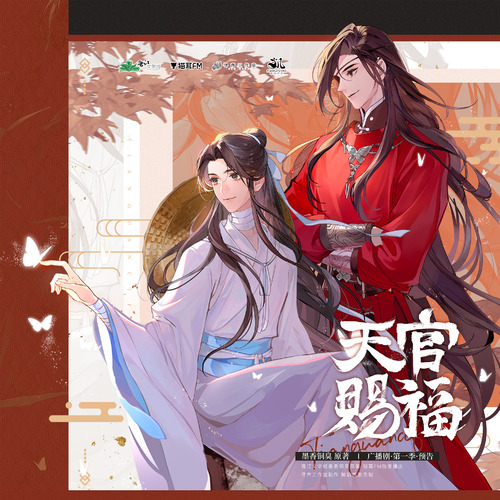
It’s coming!!!
You might recognize most of the production team as the people who worked on the MDZS audio drama, so I’m very assured that they will only have grown more experienced. Tbh I’m a little surprised by the lead VAs...excited to hear what their performances will be like!
Even more exciting: apparently the audio drama has been adapted from the revised edition of TGCF which includes 100k extra words!!!
Below is a quick translation of the season one details.
S1 Details
Link: www.missevan.com/mdrama/52400
Length: 19 episodes
Airing Schedule: Fridays, beginning July 15, 2022
Cost: 319 diamonds. For two months starting from July 15, this drama will be free to listen. Regular paid listening will resume on September 16.
Production Team
Original Novel: MXTX
Planning/Executive Producer: Kuo Hao Jun 括号君
Scriptwriter: Liu Yin 六音
Post-Production: Xin Tong 新桐
Assistants: Er Ji 二吉 , Yu Chen 鱼宸
Original BGM: Li Da Bai 李大白
Instrumental Recording: International Master Philharmonic Orchestra 国际首席爱乐乐团 IMPO
Art/Video: ARThorizon 绘享视界
Voice Team
Voice Acting Team: Jing Yun Kai Ge 鲸韵凯歌
Voice Director: Zhang Kai 张凯
Recording Engineers: Liu Yaxue 刘雅雪, Li Mian 李冕, Jiang Cong 姜聪
... ... ...
Narrator: Zhang Yaohan 张遥函
Xie Lian: Su Shangqing 苏尚卿@西呱双
Hua Cheng: Chenzhang Taikang 陈张太康
Fu Yao/Mu Qing: Liu Sicen 刘思岑
Feng Xin/Nan Feng: Guo Haoran 郭浩然
Ling Wen: Ji Guanlin 季冠霖
Ming Yi: Peng Yao (San Tu Bi An) 彭尧@彭尧-三途彼岸
Pei Ming: Chen Guang (Chen Jiaheng) 陈光@陈光家恒
Pei Xiu: Wu Tao (Dao Mei Si Le) 吴韬 @倒霉死勒
Jun Wu: Chen Hao 陈浩
Ban Yue: Shan Xin 山新
Lang Qianqiu: Li Xin 李昕
Ke Mo: Tute Hameng 图特哈蒙
Xuan Ji: Qiu Qiu 邱邱
Shi Qingxuan: Qian Wenqing 钱文青
Other Participating Voice Actors: Cai Jie (蔡杰@CJCDD-), Li Wangsong (李望松@摩羯-阿松松松松), Shao Chenliang (邵晨亮@c位不出道), Zhang Zhen/Lin Feng (张振@在下林风), Liu Zheng (刘峥@斗珂), Zhang Jiaqi (张加麒@张如麟), Liu Yiming (刘一鸣@痞人姓刘), Xu Kai (许凯@山己几X), Li Jiaxiang (李嘉祥@优叉UX), Lin Boqing (林柏青@詹永兵的好朋友), Li Haojia (李昊甲@最后的都灵人), Li Jiasi (李佳思@光的岸面), Li Yemeng (李叶萌@肆鸢), Yu Minglu (于鸣鹿@火不土), Su La (苏拉@亲爱的苏), Zhang Yuwei (张宇微@夕棠-就是喜糖啊), Xie Ziwei (谢子溦@Viona嘴嘴), Liu Yuanyuan (刘媛媛@画大染), Gao Yixue (高一雪@思凡吧喳嘿), Yu Mengci (余梦慈@晶玉瑪瑙)
190 notes
·
View notes
Note
Ji ji fu ji ji
a o e i i er ai ei ao ou an en ang eng ong i ia iao ie iu ian in iang ing iong u ua uo uai ui uan un uang ueng ü üe üan ün a o e er ai ao ou an en ang eng yi ya yao ye you yan yin yang ying yong wu wa wo wai wei wan wen wang weng yu yue yuan yun b ba bo bai bei bao ban ben bang beng bi biao bie bian bin bing bu p pa po pai pei pao pou pan pen pang peng pi piao pie pian pin ping pu m ma mo me mai mei mao mou man men mang meng mi miao mie miu mian min ming mu f fa fo fei fou fan fen fang feng fu d da de dai dei dao dou dan den dang deng dong di diao die diu dian ding du duo dui duan dun t ta te tai tei tao tou tan tang teng tong ti tiao tie tian ting tu tuo tui tuan tun n na ne nai nei nao nou nan nen nang neng nong ni niao nie niu nian nin niang ning nu nuo nuan nü nüe l la le lai lei lao lou lan lang leng long li lia liao lie liu lian lin liang ling lu luo luan lun lü lüe g ga ge gai gei gao gou gan gen gang geng gong gu gua guo guai gui guan gun guang k ka ke kai kei kao kou kan ken kang keng kong ku kua kuo kuai kui kuan kun kuang h ha he hai hei hao hou han hen hang heng hong hu hua huo huai hui huan hun huang z za ze zi zai zei zao zou zan zen zang zeng zong zu zuo zui zuan zun c ca ce ci cai cao cou can cen cang ceng cong cu cuo cui cuan cun s sa se si sai sao sou san sen sang seng song su suo sui suan sun zh zha zhe zhi zhai zhei zhao zhou zhan zhen zhang zheng zhong zhu zhua zhuo zhuai zhui zhuan zhun zhuang ch cha che chi chai chao chou chan chen chang cheng chong chu chua chuo chuai chui chuan chun chuang sh sha she shi shai shei shao shou shan shen shang sheng shu shua shuo shuai shui shuan shun shuang r re ri rao rou ran ren rang reng rong ru rua ruo rui ruan run j ji jia jiao jie jiu jian jin jiang jing jiong ju jue juan jun q qi qia qiao qie qiu qian qin qiang qing qiong qu que quan qun x xi xia xiao xie xiu xian xin xiang xing xiong xu xue xuan xun
15 notes
·
View notes
Photo
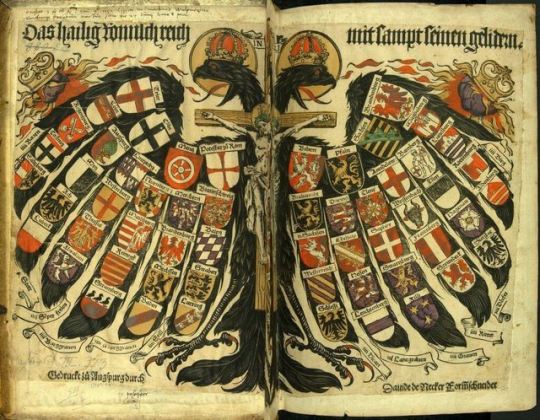





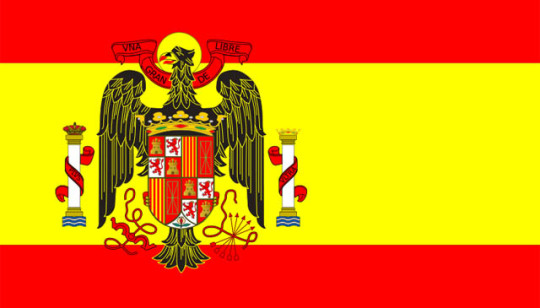



“The earliest depiction of the double-headed eagle can be found on ancient on Hittite monuments in central Anatolia. In the early 19th century, in Boğazkale, an old Hittite capital in modern-day Turkey...The double-headed eagle motif originally dates from c. 3800 BC. The Hittites had worshiped the double headed eagle as the King of Heaven, who was also called the Hittite Bird of the Sun. The bird was their symbol to signify Hittite military power.”

”The bird bird appears in Lygash under the name of Imgig, and was the Sumerian symbol for the god of Lagash, Ninurta son of Enlil...the double-headed eagle, however, is not restricted to supporting deities, and also appears supporting human figures. This is an indication of the use of the eagle as a personal (or family) symbol...The Seliuk Turks referred to it as Hamca and among the Zuni it appeared as a highly conventionalized design, but still as a double-headed thunder bird, the Sikyatki.”
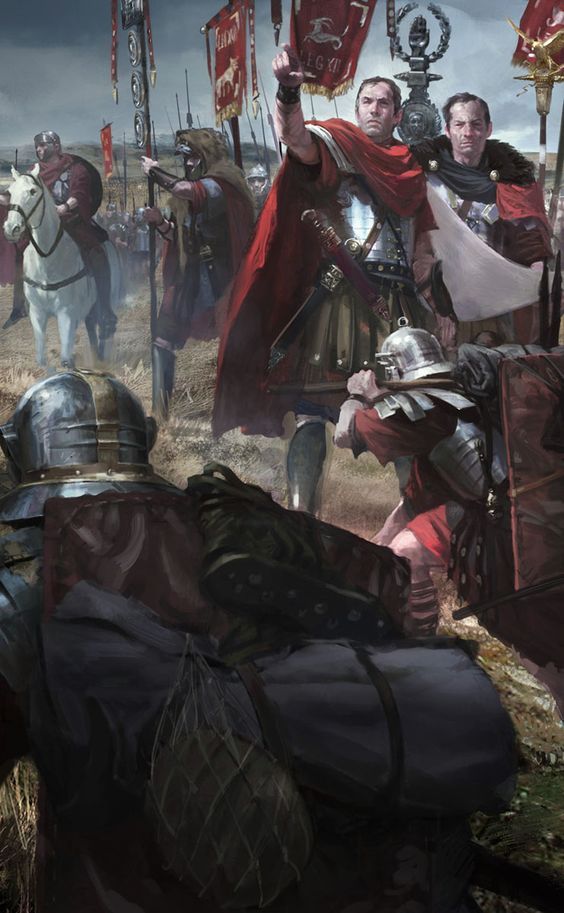
”The double-headed eagle has been used as an emblem by countries, nations, and royal houses in Europe since the early medieval period. Notable examples include the Byzantine House of Palaiologos, the Holy Roman Empire, the House of Habsburg, and the Ruriks and Romanovs of Russia. The symbol often appears on countries’ coats of arms and flags. The emblem was adopted by the Russians, Poles, Serbians, Prussians, Austrians and Saxons. It was used as a private seal and as arms in Germany, Spain, France, Netherlands, England, and Russia.”
(via Mystery Of The Ancient Double-Headed Eagle Symbol | Locklip)
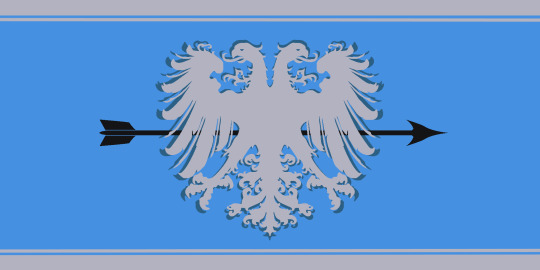
Double Headed Eagle iconology of Byzantium
“Greek scholars have tried to make links with ancient symbols: the eagle was a common design representing power in ancient city-states, while there was an implication of a "dual-eagle" concept...However, there is virtually no doubt that its origin is a blend of Roman and Eastern influences. Indeed, the early Byzantine Empire inherited the Roman eagle (extended wings, head facing right) as an imperial symbol.”

“[T]he church of Greece kept, and is to this date still using Byzantine flags with the eagle, usually black on yellow/gold background. But after the Ottoman conquest this symbol also found its way to a "new Constantinople" (or Third Rome), i.e. Moscow. Russia, deeply influenced by the Byzantine Empire, saw herself as its heir and adopted the double-headed eagle as its imperial symbol. It was also adopted by the Serbs, the Montenegrins, the Albanians and a number of Western rulers, most notably in Germany and Austria.”
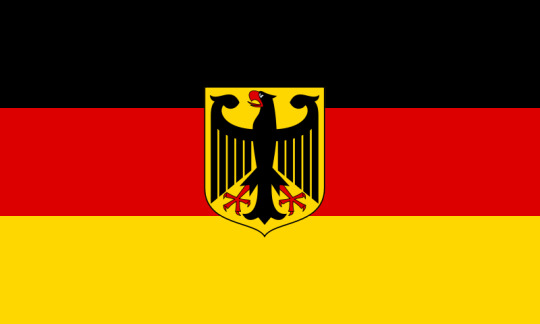
“The first mention of a double-headed eagle in the West dates from 1250 in a roll of arms of Matthew of Paris for Emperor Friedrich II. Theodore II Laskaris chose it for his symbol as Emperor (Empire of Nicaea), taking it to symbolize his state's claims to all the Byzantine Empire's former domains, both European (West) and Asian (East)... After the recapture of Constantinople and the restoration of the Byzantine Empire, the symbol was used as an emblem of the imperial family, but it is uncertain whether it was the official emblem of the Empire.”

“The double-headed eagle became the standard of the Seljuk Turks with the crowning of Toghrül (meaning "Eagle") Beg at Mosul in 1058 as "King of the East and the West" and was much used afterwards. The Sultans of Rum, Ala ad-Din Kay Qubadh I (1220-1237) and his son Kay Khusrau II (1237-1246) used the bicephalous eagle in their standards, and the motif was also found on tissues, cut stones, mural squares, and Koran holders.”
(via Double Headed Eagle iconology of Byzantium | Kythera Family blog)

The double-headed eagle of the Third Rome
“When looking carefully, you can distinguish 9 coats of arms on the eagle. However, in most cases, these shields are printed so tiny that few details can be revealed. The center shield on the eagle's chest is the one with the arms of Moscow. Then, in clockwise order starting from the heads, we see the arms of [Khanate of] Astrakhan, [Khanate of] Siberia, [Kingdoms & Principalities of] Georgia, [Grand Duchy of] Finland, [Grand Principalities of] Kiev-Vladimir-Novgorod, [Khanate of] Taurica, [Kingdom of] Poland and [Khanate of] Kazan...this double-headed eagle represents about 500 years of Russian imperial history.”
(via The double-headed eagle of the Third Rome | Franky’s Scripophily BlogSpot)
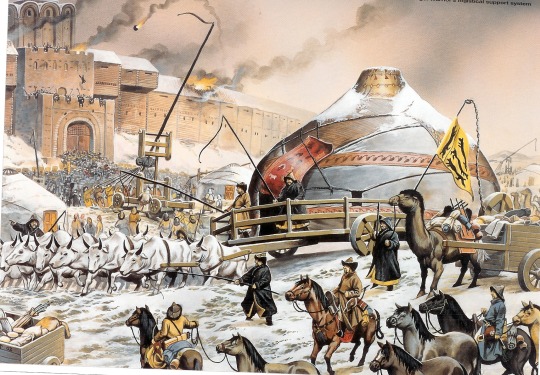
Kiev and the Byzantine Legacy in Russia
“The history of Kiev begins under the rule of the Rus. The Rus (also known as Varangians) were original Vikings who began to trade along the Volga River and later the Dnieper River. They establish several principalities centered on cities like Novgorod and later Kiev...Vladimir was also among the rulers of Kiev who gave military assistance to the Byzantines, leading to the formation of the Varangian Guard...Saint Sophia's Cathedral in Kiev, which dates to the early 11th century. It was designed rival Hagia Sophia in Constantinople, thus symbolizes Kiev as the 'new Constantinople'. There was even a Golden Gate in Kiev, named after the famous Golden Gate of Constantinople. In addition, the Kiev Monastery of the Caves date to 1051 and were influential in the spread of Orthodox thought.“
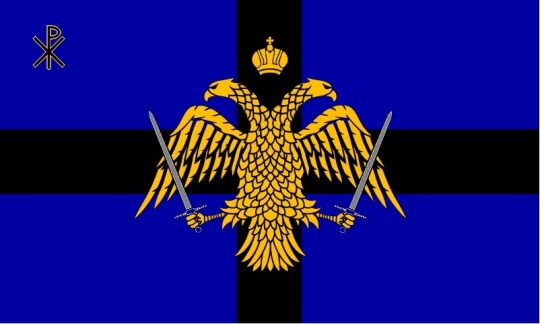
“As the Byzantine Empire was slowly dying, Moscow began to grow in power. The Metropolitan of Kiev moved to Moscow in the 14th century as the Tatars undermined the power of Kiev. Ivan III (1440-1505), the Grand Prince of Moscow, ended the dominance of the Golden Horde in Russia, and became to expand his own power. In 1472, He married Sophia Palaiologina, the niece of the last Byzantine Emperor, after the fall of Constantinople. He would then claim that Moscow was the “Third Rome” and by the end of the 16th century, the Metropolitan of Moscow claimed the title of patriarch. The title Tsar also reflects this claim to be the successor of Constantinople. In fact, the Russian Empire’s symbol was the Byzantine Double Eagle until the Soviet’s overthrew Tsar Nicholas II. This symbol has since returned after the fall of the Soviet Union.“

Mongol-Papal Encounter: Letter Exchange between Pope Innocent IV and Güyük Khan in 1245-1246
“By the late 1230s, Mongol armies had begun raiding parts of Russia and eastern Europe. Between 1236 and 1242, these military campaigns–commanded by Subutai (d. 1248), Batu Khan (d. 1255), and Berke (d. 1266), among others–had wrought major devastation across Russia, Poland, Hungary and the Balkans. The cities of Kiev, Pereyaslavl, Chernihiv, Lublin, and other major population centers in eastern and central Europe were sacked and their populations massacred.”
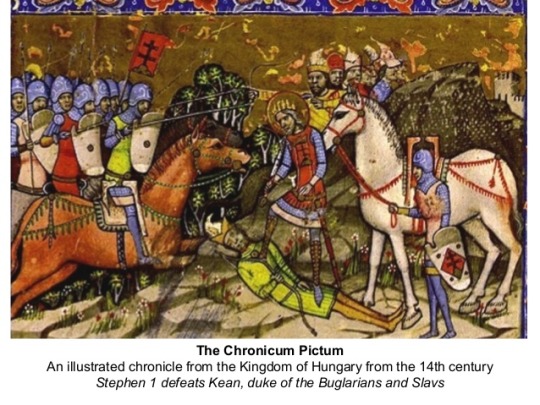
“The defeats of the Polish forces at the Battle of Liegnitz/Legnica (April 9th 1241) and the Hungarian military at the Battle of Mohi (April 11th 1241) opened up most of the Balkans and Central Europe to Mongol raids, leading to even more destruction, displacement and massacres. These alarming developments shook the foundations of Latin Christendom. Although the Mongols withdrew from most of the Balkans and east-central Europe soon after”
(via Mongol-Papal Encounter: Letter Exchange between Pope Innocent IV and Güyük Khan in 1245-1246 | Ballandalus blog)
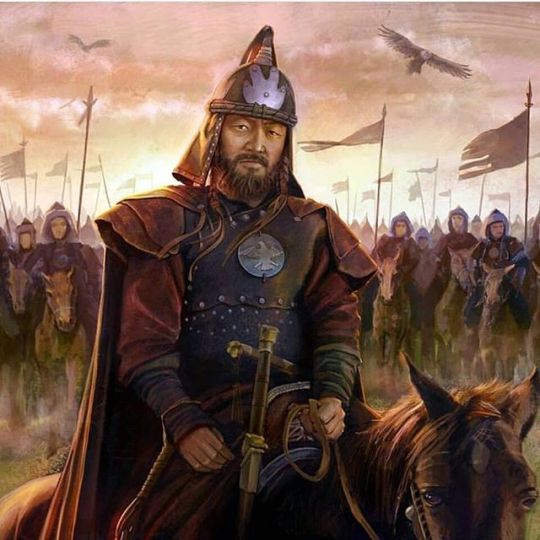
Borjigin
“A Borjigin or Borjigid is a member of the sub-clan, which started with Yesugei (but the Secret History of the Mongols makes it go back to Yesugei's ancestor Bodonchar), of the Kiyat clan. Yesugei's descendants were thus said to be Kiyat-Borjigin. The senior Borjigid provided ruling princes for Mongolia and Inner Mongolia until the 20th century. The clan formed the ruling class among the Mongols and some other peoples of Central Asia and Eastern Europe.”
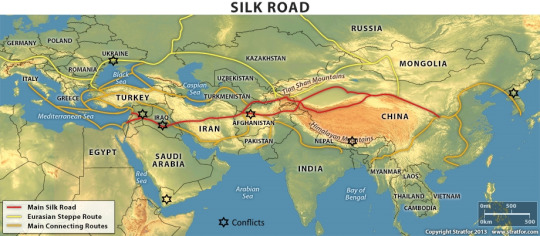
“The Borjigin family ruled over the Mongol Empire from the 13th to 14th century. The rise of Genghis (Chingis) narrowed the scope of the Borjigid-Kiyad clans sharply. This separation was emphasized by the intermarriage of Genghis's descendants with the Barlas, Baarin, Manghud and other branches of the original Borjigid.”

”In the western regions of the Empire, the Jurkin and perhaps other lineages near to Genghis's lineage used the clan name Kiyad but did not share in the privileges of the Genghisids. The Borjigit clan had once dominated large lands stretching from Java to Iran and from Indo-China to Novgorod. In 1335, with the disintegration of the Ilkhanate in Iran, the first of numerous non-Borjigid-Kiyad dynasties appeared. Established by marriage partners of Genghisids, these included the Suldus Chupanids, Jalayirids in the Middle East, the Barulas dynasties in Chagatai Khanate and India, the Manghud and Onggirat dynasties in the Golden Horde and Central Asia, and the Oirats in western Mongolia.In 1368, under Toghun Temür, the Yuan dynasty was overthrown by the Ming dynasty in China but members of the family continued to rule over Mongolia homeland into the 17th century, known as the Northern Yuan dynasty.”
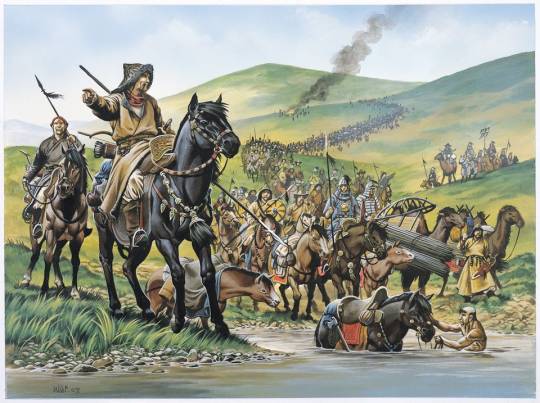
“After the breakup of the Golden Horde, the Khiyat continued to rule the Crimea and Kazan until the late 18th century. They were annexed by the Russian Empire and the Chinese...The Qing dynasty respected the Borjigin family and the early emperors married the Hasarid Borjigids of the Khorchin. Even among the pro-Qing Mongols, traces of the alternative tradition survived. Aci Lomi, a banner general, wrote his History of the Borjigid Clan in 1732–35. The 18th century and 19th century Qing nobility was adorned by the descendants of the early Mongol adherents including the Borjigin.”

“Genghis Khan founded the Mongol Empire in 1206. His grandson, Kublai Khan, after defeating his younger brother Ariq Böke, founded the Yuan dynasty in China in 1271. The dynasty was overthrown by the Ming dynasty during the reign of Toghaghan-Temür in 1368, but it survived in Mongolia homeland, known as the Northern Yuan dynasty.”

Bahri dynasty
“The Bahri dynasty or Bahriyya Mamluks was a Mamluk dynasty of mostly Cuman-Kipchak Turkic origin that ruled the Egyptian Mamluk Sultanate from 1250 to 1382. They followed the Ayyubid dynasty, and were succeeded by a second Mamluk dynasty, the Burji dynasty."
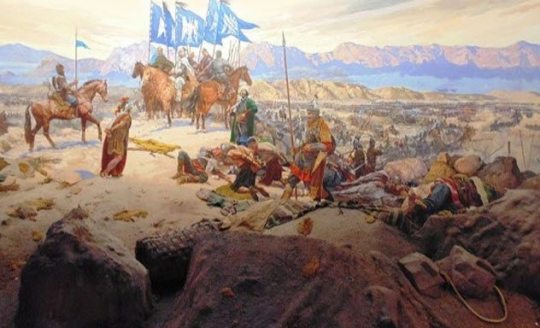

Burji dynasty
“From 1250 Egypt had been ruled by the first Mamluk dynasty, the mostly Cuman-Kipchak Turkic Bahri dynasty. In 1377 a revolt broke out in Syria which spread to Egypt...Barquq was proclaimed sultan in 1382, ending the Bahri dynasty...Permanently in power, he founded the Burji dynasty.”
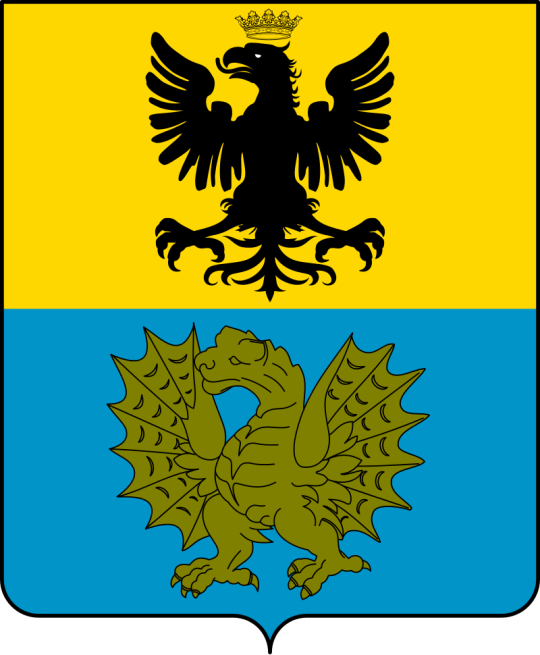
House of Borghese
“Borghese is the surname of a princely family of Italian noble and papal background, originating as the Borghese or Borghesi in Siena, where they came to prominence in the 13th century holding offices under the commune. The head of the family, Marcantonio, moved to Rome in the 16th century and there, following the election (1605) of his son Camillo as Pope Paul V they rose in power and wealth. They were one of the leading families of the Black Nobilityand maintain close ties to the Vatican.”

Guelphs and Ghibellines
“The Guelphs and Ghibellines were factions supporting the Pope and the Holy Roman Emperor, respectively, in the Italian city-states of central and northern Italy. During the 12th and 13th centuries, rivalry between these two parties formed a particularly important aspect of the internal politics of medieval Italy.”
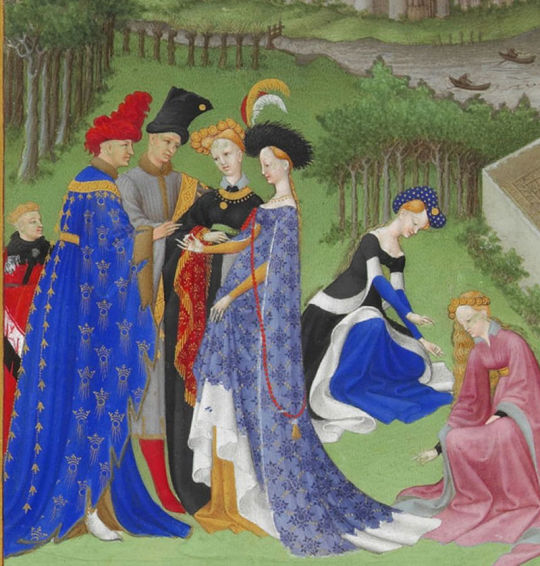
”The names were likely introduced to Italy during the reign of Frederick Barbarossa. When Frederick conducted military campaigns in Italy to expand imperial power there, his supporters became known as Ghibellines (Ghibellini). The Lombard League and its allies were defending the liberties of the urban communes against the Emperor's encroachments and became known as Guelphs (Guelfi). The Ghibellines were thus the imperial party, while the Guelphs supported the Pope. Broadly speaking, Guelphs tended to come from wealthy mercantile families, whereas Ghibellines were predominantly those whose wealth was based on agricultural estates.”
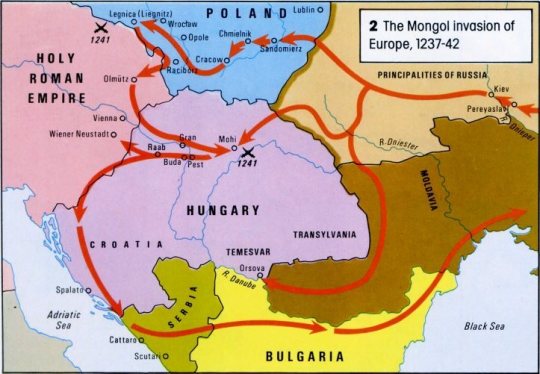
Frederick II, Holy Roman Emperor
“In 1241–1242, the forces of the Golden Horde decisively defeated the armies of Hungary and Poland and devastated their countryside and all their unfortified settlements. King Béla IV of Hungary appealed to Frederick for aid, but Frederick, being in dispute with the Hungarian king for some time (as Bela had sided with the Papacy against him) and not wanting to commit to a major military expedition so readily, refused. He was unwilling to cross into Hungary, and although he went about unifying his magnates and other monarchs to potentially face a Mongol invasion, he specifically took his vow for the defense of the empire on "this side of the Alps."

”Frederick was aware of the danger the Mongols posed, and grimly assessed the situation, but also tried to use it as leverage over the Papacy to frame himself as the protector of Christendom. While he called them traitorous pagans, Frederick expressed an admiration for Mongol military prowess after hearing of their deeds, in particular their able commanders and fierce discipline and obedience, judging the latter to be the greatest source of their success. He called a levy throughout Germany while the Mongols were busy raiding Hungary. In mid 1241 Federick dispersed his army back to their holdfasts as the Mongols preoccupied themselves with the lands east of the Danube, attempting to smash all Hungarian resistance. He subsequently ordered his vassals to strengthen their defenses, adopt a defensive posture...A chronicler reports that Frederick received a demand of submission from Batu Khan at some time.”
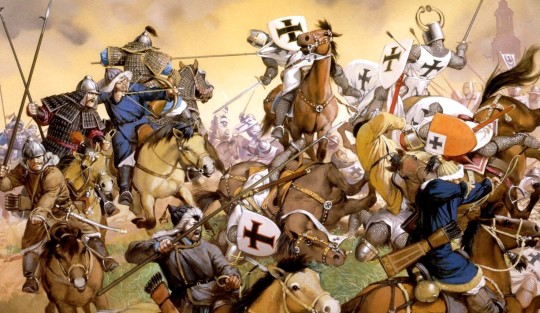
“A letter written by Emperor Frederick II, found in the Regesta Imperii, dated to June 20, 1241, and intended for all his vassals in Swabia, Austria, and Bohemia, included a number of specific military instructions. His forces were to avoid engaging the Mongols in field battles, hoard all food stocks in every fortress and stronghold, and arm all possible levies as well as the general populace.
Mongol probing attacks materialised on the Holy Roman Empire's border states...A full-scale invasion never occurred, as the Mongols spent the next year pillaging Hungary before withdrawing. After the Mongols withdrew from Hungary back to Russia, Frederick turned his attention back towards Italian matters.”

Pope Innocent IV
“In 1245, Innocent IV issued bulls and sent an envoy in the person of Giovanni da Pian del Carpine (accompanied by Benedict the Pole) to the "Emperor of the Tartars". The message asked the Mongol ruler to become a Christian and stop his aggression against Europe. The Khan Güyük replied in 1246 in a letter written in Persian that is still preserved in the Vatican Library, demanding the submission of the Pope and the other rulers of Europe...two Mongolian envoys to the Papal seat in Lyon, Aïbeg and Serkis. In the letter Guyuk demanded that the Pope appear in person at the Mongol imperial headquarters, Karakorum in order that “we might cause him to hear every command that there is of the jasaq”.
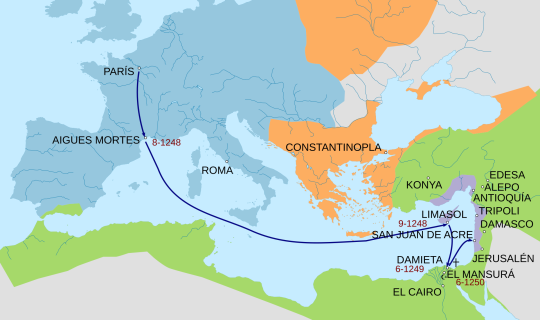
Seventh Crusade
“In 1244, the Khwarezmians, recently displaced by the advance of the Mongols, took Jerusalem on their way to ally with the Egyptian Mamluks. This returned Jerusalem to Muslim control, but the fall of Jerusalem was no longer a crucial event to European Christians, who had seen the city pass from Christian to Muslim control numerous times in the past two centuries. This time, despite calls from the Pope, there was no popular enthusiasm for a new crusade. There were also many conflicts within Europe that kept its leaders from embarking on the Crusade.”
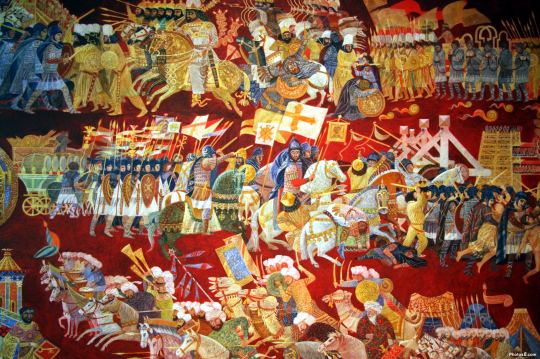
“Pope Innocent IV and Frederick II, Holy Roman Emperor continued the papal-imperial struggle. Frederick had captured and imprisoned clerics on their way to the First Council of Lyon, and in 1245 he was formally deposed by Innocent IV. Pope Gregory IX had also earlier offered King Louis' brother, count Robert of Artois, the German throne, but Louis had refused. Thus, the Holy Roman Emperor was in no position to crusade. Béla IV of Hungary was rebuilding his kingdom from the ashes after the devastating Mongol invasion of 1241.”
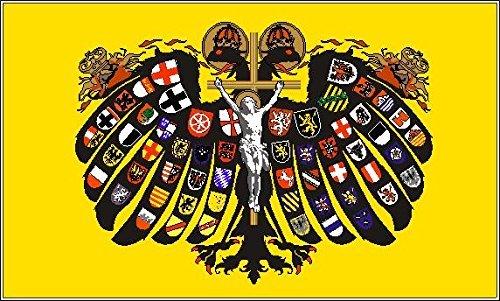
Interregnum (Holy Roman Empire)
“The term Great Interregnum is occasionally used for the period between 1250 (death of Frederick II) and 1273 (accession of Rudolf I)...After the deposition of Frederick II by Pope Innocent IV in 1245...in 1273, Rudolf I of Germany, a minor pro-Staufen count, was elected. He was the first of the Habsburgs to hold a royal title, but he was never crowned emperor. After Rudolf's death in 1291, Adolf and Albert were two further weak kings who were never crowned emperor...Sigismund (r. 1411 – 1437) was crowned emperor in 1433, but only with Frederick III (r. 1452 – 1493), the second emperor of the House of Habsburg, did the Holy Roman Emperor return to an unbroken succession of emperors (with the exception of Charles VII all of the House of Habsburg) until its dissolution in 1806.”

Franco-Mongol alliance
“European attitudes began to change in the mid-1260s, from perceiving the Mongols as enemies to be feared, to potential allies against the Muslims. The Mongols sought to capitalize on this, promising a re-conquered Jerusalem to the Europeans in return for cooperation. Attempts to cement an alliance continued through negotiations with many leaders of the Mongol Ilkhanate in Persia, from its founder Hulagu through his descendants Abaqa, Arghun, Ghazan, and Öljaitü, but without success. The Mongols invaded Syria several times between 1281 and 1312, sometimes in attempts at joint operations with the Franks, but the considerable logistical difficulties involved meant that forces would arrive months apart, never able to coordinate activities in any effective way...the Egyptian Mamluks successfully recaptured all of Palestine and Syria from the Crusaders.”
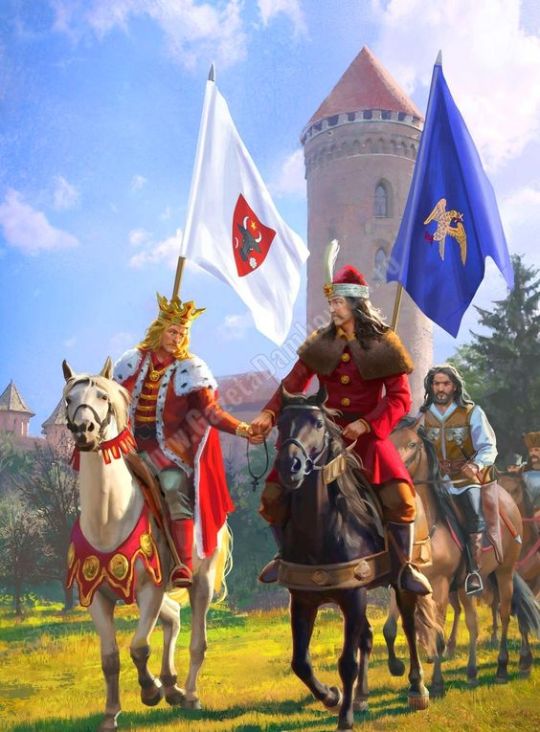
“Christian kings began to prepare for a new crusade (the Seventh Crusade), declared by Pope Innocent IV in June 1245 at the First Council of Lyon. The loss of Jerusalem caused some Europeans to look to the Mongols as potential allies of Christendom, provided the Mongols could be converted to Western Christianity. In March 1245, Pope Innocent IV had issued multiple papal bulls, some of which were sent with an envoy, the Franciscan John of Plano Carpini, to the "Emperor of the Tartars". In a letter now called the Cum non solum, Pope Innocent expressed a desire for peace, and asked the Mongol ruler to become a Christian and to stop killing Christians. However, the new Mongol Great Khan Güyük, installed at Karakorum in 1246, replied only with a demand for the submission of the pope, and a visit from the rulers of the West in homage to Mongol power:”

Hohenstaufen
“The Hohenstaufen also known as Staufer, were a dynasty of German kings (1138–1254) during the Middle Ages. Before ascending to the kingship, they were Dukes of Swabia from 1079. As kings of Germany, they had a claim to Italy, Burgundy and the Holy Roman Empire. Three members of the dynasty—Frederick I (1155), Henry VI (1191) and Frederick II (1220)—were crowned emperor. Besides Germany, they also ruled the Kingdom of Sicily (1194–1268) and the Kingdom of Jerusalem (1225–1268) [succeeded by the House of Habsburg in 1268]”
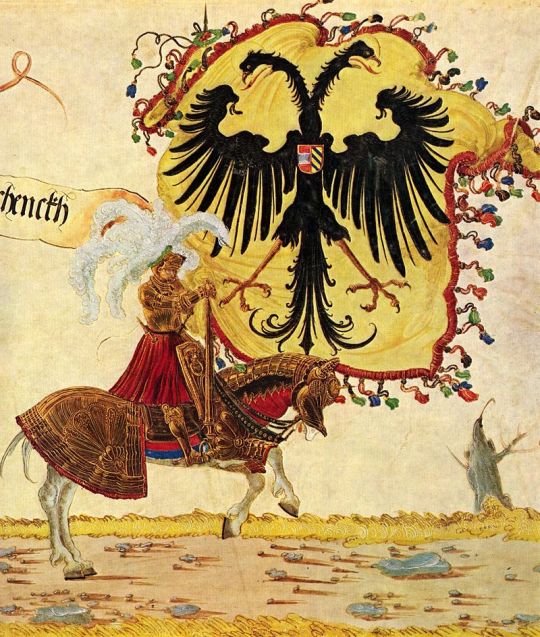
House of Habsburg
“The House of Habsburg and alternatively called the House of Austria was one of the most influential and distinguished royal houses of Europe. The throne of the Holy Roman Empire was continuously occupied by the Habsburgs from 1438 until their extinction in the male line in 1740. The house also produced emperors and kings of Bohemia, Hungary, Croatia, Galicia, Portugal and Spain with their respective colonies, as well as rulers of several principalities in the Netherlands and Italy.”

“The Habsburg Empire was never composed of a single unified and unitary state as Bourbon France, Hohenzollern Germany, or Great Britain was. It was made up of an accretion of territories that owed their historic loyalty to the head of the house of Habsburg as hereditary lord. The Habsburgs had mostly married the heiresses of these territories, most famously of Spain and the Netherlands. They used their coats of arms then as a statement of their right to rule all these territories."
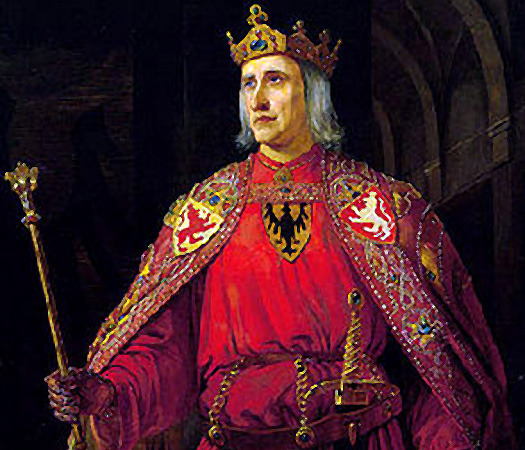
Rudolf I of Germany
“Rudolf I, also known as Rudolf of Habsburg was Count of Habsburg from about 1240 and King of Germany from 1273 until his death.Rudolf's election marked the end of the Great Interregnum in the Holy Roman Empire after the death of the Hohenstaufen emperor Frederick II in 1250.
The disorder in Germany during the interregnum after the fall of the Hohenstaufen dynasty afforded an opportunity for Count Rudolf to increase his possessions. His wife was a Hohenberg heiress; and on the death of his childless maternal uncle Count Hartmann IV of Kyburg in 1264, he also seized his valuable estates.”

Kyburg family
“Kyburg also Kiburg was a noble family of grafen (counts) in the Duchy of Swabia, a cadet line of the counts of Dillingen, who in the late 12th and early 13th century ruled the County of Kyburg, corresponding to much of what is now Northeastern Switzerland.The family was one of the four most powerful noble families in the Swiss plateau beside the House of Habsburg, House of Zähringen and the House of Savoy during 12th century. With the extinction of the Kyburg family's male line in 1264, Rudolph of Habsburg laid claim to the Kyburg lands and annexed them to the Habsburg holdings, establishing the line of "Neu-Kyburg", which was in turn extinct in 1417.”
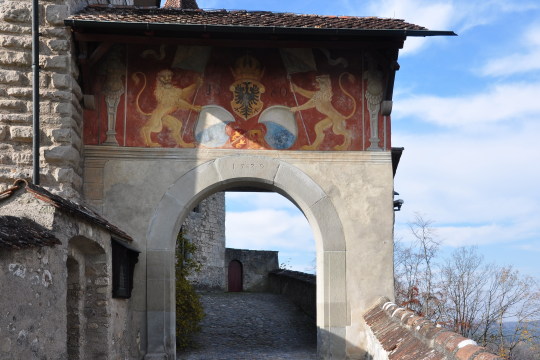
“In 1250/51 the childless Hartmann IV gave the western part of the property with the center of Burgdorf to his nephew Hartmann V. As a result, Hartmann V, who was supported by the Habsburgs, came into conflict repeatedly with the growing city-state of Bern. His uncle had to step in often to keep the peace. When Hartmann V died in 1263, Count Rudolf von Habsburg became the guardian of Hartmann's daughter Anna, and also took over the administration of the western section. In 1264, after the death of Hartman IV, Rudolf stepped in to control the eastern half as well. Though this brought him into conflict with the claims by the widow Margaret of Savoy and her family.”

”Anna, daughter of Hartmann V, married Eberhard I of Habsburg-Laufenburg. This marriage was intended to secure Habsburg interests in Aargau (Argovia) against Savoy. The son of Eberhard and Anna, Hartmann I (1275–1301) again called himself "of Kyburg". His line came to be known as that of Neu-Kyburg or Kyburg-Burgdorf, persisting until 1417.”

House of Borgia
“The House of Borgia was an Italo-Spanish noble family, which rose to prominence during the Italian Renaissance. They were from Aragon, the surname being a toponymic from the town of Borja, then in the Crown of Aragon, in Spain.The Borgias became prominent in ecclesiastical and political affairs in the 15th and 16th centuries, producing two popes: Alfons de Borja, who ruled as Pope Callixtus III during 1455–1458, and Rodrigo Lanzol Borgia, as Pope Alexander VI, during 1492–1503.”

Name of Turkey
“The English name Turkey, now applied to the modern Republic of Turkey, is historically derived (via Old French Turquie) from the Medieval Latin Turchia, Turquia. It is first recorded in Middle English (as Turkye, Torke, later Turkie, Turky), attested in Chaucer, ca. 1369. The Ottoman Empire was commonly referred to as Turkey or the Turkish Empire
The English name of Turkey (from Medieval Latin Turchia/Turquia) means "land of the Turks"...The phrase land of Torke is used in the 15th-century Digby Mysteries. Later usages can be found in the Dunbar poems, the 16th century Manipulus Vocabulorum ("Turkie, Tartaria")...The medieval Greek and Latin terms did not designate the same geographic area now known as Turkey. Instead, they were mostly synonymous with Tartary, a term including Khazaria and the other khaganates of the Central Asian steppe, until the appearance of the Seljuks and the rise of the Ottoman Empire in the 14th century...The Arabic cognate Turkiyya (Arabic: تركيا) in the form Dawla al-Turkiyya (State of the Turks) was historically used as an official name for the medieval Mamluk Sultanate which covered Egypt, Palestine, Syria, Hejaz and Cyrenaica.”

What’s the Word for Turkey in Turkish?
“The word for turkey in Turkish is hindi.What? OK, so what’s the Hindi word for turkey?Turns out that the word for turkey in Hindi is टर्की. And that, if you don’t know Devanagari, is transcribed ṭarkī in the Latin alphabet.
Turkeys are native to the Americas, but the Europeans first encountering them thought that they looked like a kind of guinea fowl, another large, ungainly, colorful-faced kind of bird. Now, guinea fowl were also called turkey fowl, but that’s because they actually had a legitimate connection to Turkey the country: Europeans received most of their guinea fowl imported via Turkey...the first turkeys brought to Europe also generally came via Turkey: The birds had originally been domesticated by the Aztecs and were brought to Europe by Spanish conquistadores, who traded them to the rest of the continent via North Africa.
Japanese and Korean call it the equivalent of “seven-faced bird,” Abkhazian and other languages in the Caucasus call it “blue bird,” and Thai and Urdu call it “elephant chicken” or “elephant trunk chicken.”
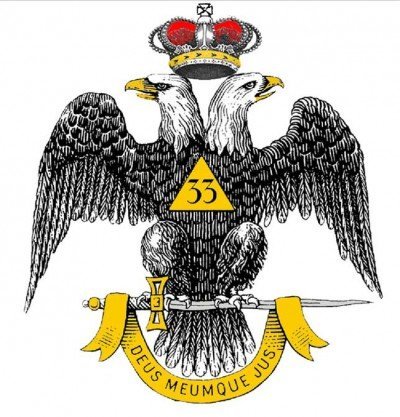
(via What’s the Word for Turkey in Turkish? | Slate)
#turkey#silkroad#chainofcommerce#noblemerchantclans#ambasadorsorspies#kiyat#borjigin#burji#borgia#borghese#kiburg#ghibelines#holyromanempire#rudolfofhapsburg#hapsburgdynasty#vladtheimpaler#transylvania#house of saxe-coburg and gotha#popeinnocentiv#guyukkhan#mongolultimatum#marriagealliance#tributetax#wagewarfortribute#secrethistoryofthemongols#doubleheadedeagle#goldenhorde#goldenorder
16 notes
·
View notes
Text
Yunnan Xuanwei Ham (宣威火腿/xuān wēi huó tuǐ) Eben van Tonder 10 May 2020
Introduction
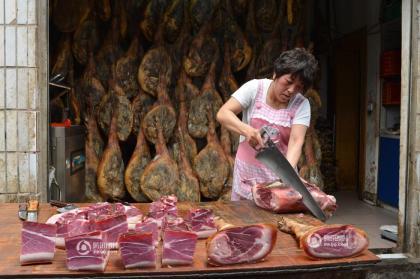
Xuanwei Han in Xuanwei City. Reference China on the Way.
Yunnan is one of China’s premium food regions known for exquisite tastes. One of the major cities in this picturesque region is Xuanwei, where one of the world famous Chinese hams are produced, the others being Jinhua Ham from Zhejiang province and Rugao Ham from Jiangsu province. Yunnan Xuanwei Ham is known for its fragrance, appearance, and out-of-the-world taste. Through the ages, there have been many references in literature to the health benefits associated with the hams. In order to produce these hams, there are at least two ingredients without which the hams can not be produced. The first ingredient is salt.
The Industrialisation of Ham
Early references to Xuanwei hams go back to 1766. “Old chronicles recorded the Qing emperor Yong Zheng five years (the year 1727) located XuanWei (a city of YunNan province, China), so it is called XuanWei ham. (China on the Way) In 1909, Zhuo Lin’s (Deng Xiaoping’s third wife) father Pu Zai Ting, a businessman, mass-produced it for the first time. He established Xuanhe Ham Industry Company Limited. His company sent food technicians to Shanghai, Guangzhou (formerly Canton), and Japan to learn advanced food processing technology.
One example of the excellence pursued in Guangzhou relates to the cultivation of rice. Rice breeding began in China in 1906. However, by 1919, systematic and well-targeted breeding using rigorous methodologies was started at Nanjing Higher Agricultural School and Guangzhou Agricultural Specialized School. Between 1919 and 1949, 100 different rice varieties were bred and released. (Mew, et al., 2003) For a riveting look at the trade in Guangzhou, see the work by Dr. Peter C. Perdue, Professor of History, Yale University, Canton Trade.
By all accounts, Pu Zaiting was successful in creating a world famous ham (at least by probably standardising and industrialising the process). In 1915 Xuanwei ham won a Gold Medal at Panama International Fair. The ham, which, in the Qing and Ming Dynasties, was a necessary gift for friends and guests and which, during the gourmet festival, became the main ingredient to create different delicious dishes achieved international acclaim. (chinadaily.com)
The Xuanhe Canned Ham Industry Company Limited was established on the back of canning equipment bought from the United States of America to produce canned ham. Most of what it produced were exported overseas. In 1923 Sun Yat-sen tasted the ham at the National Food Exhibition held in Guangzhou. Sun famously wrote of the ham, “yin he shi de” translating as “eat well for a sound mind!” By 1934, four companies were producing the canned ham. (Kristbergsson and Oliveira, 2016)
Xuanwei Ham expanded greatly under the People’s Republic of China, established in 1949. Supporting industries started to develop. A factory was created to supply the cans used by the Municipal Authority of Kunming City. (Kristbergsson and Oliveira, 2016)
Production of Xuanwei hams rose by 1999 to 13 000 tonnes, made by 38 large producers. In 2001 it got the status of a regional brand, protected by the People’s Republic of China. A Chinese standard, GB 18357-2003 was subsequently issued. By 2004 production rose to 20,750 tonnes with technology in manufacturing and packaging improving continuously. (Kristbergsson and Oliveira, 2016)
Apart from a rich and competitive environment, an entrepreneur, as the proverb goes, worth his salt, was needed to bring discipline to the production process and to establish this ham among the finest on earth. In achieving this status, three elements were required, namely salt, the right meat and a solid production technique to yield this culinary masterpiece on an industrial scale.
Yunnan – Centre of Culinary Excellence
The first requirement for competitiveness is an environment of excellence and innovation. The environment where this exquisite ham is produced testifies to culinary excellence. Like Prague, which produced the ham press, nitrite curing and the famous Prague hams, the Yunnan hams likewise hail from an area replete with food and cooking innovations. Yunnan is located on what was known as the Southern Silk Road and its culinary excellence is seen, among other things, in the equipment used in preparing their foods. Joseph Needham, et al. reports that in restaurants in the cities of Yunnan, a very special dish is found “in which chicken, ham, meat balls and the like have been cooked in water just condensed from steam. This is done by means of an apparatus called chhi kuo (or formerly yang li kuo) made especially at Chien-shui near Kochiu. It consists simply of a red earthenware pot with a domical cover, the bottom of the pot being pierced by a tapering chimney so formed as to leave on all sides an annular trough (figure 1490). The chhi kuo once placed on a saucepan of boiling water, steam enters from below and is condensed so as to fall upon and cook the viands of the trough, resulting thus after due process in something much better than either a soup or a stew in the ordinary sense. Since the chimney tapers to a small hole at its tip no natural volatile substances are lost from the food, hence the name of the object and the purpose of its existence. The chhi kuo must claim to be regarded as a distant descendant of the Babylonian rim-pot (for it has and needs no Hellenistic side-tube) with the ancient rim expanded to form a trough, compressing the ‘still’-body to a narrow chimney. But how the idea found its way through the ages, and from Mesopotamia to Yunnan, might admit of a wide conjecture.” (Needham, et al.,1980)
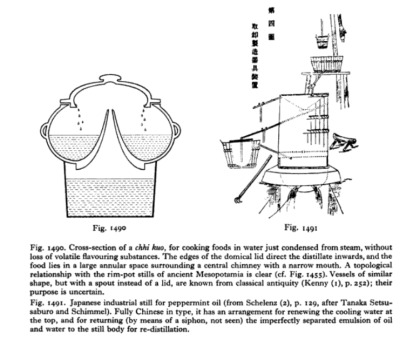
The second essential ingredient for a salt-cured ham is salt. Salt is something that China has been specialising in for thousands of years and which became the backbone of the creation of this legend.
Salt in China
Flad, et al. (2005) showed that salt production was taking place in China on an industrial scale as early as the first millennium BCE at Zhongba. “Zhongba is located in the Zhong Xian County, Chongqing Municipality, approximately 200 km down-river along the Yangzi from Chongqing City in central China. Researchers concluded that “the homogeneity of the ceramic assemblage” found at this site “suggests that salt production may already have been significant in this area throughout the second millennium B.C..” Significantly, “the Zhongba data represent the oldest confirmed example of pottery-based salt production yet found in China.” (Flad, et al.; 2005)
Salt-cured Chinese hams have been in production since the Tang Dynasty (618-907AD). First records appeared in the book Supplement to Chinese Materia Medica by Tang Dynasty doctor Chen Zangqi, who claimed ham from Jinhua was the best. Pork legs were commonly salted by soldiers in Jinhua to take on long journeys during wartime, and it was imperial scholar Zong Ze who introduced it to Song Dynasty Emperor Gaozong. Gaozong was so enamored with the ham’s intense flavour and red colour he named it huo tui, or ‘fire leg’. (SBS) An earlier record of ham than Jinhua-ham is Anfu ham from the Qin dynasty (221 to 206 BCE).
In the middle ages, Marco Polo is said to have encountered salt curing of hams in China on his presumed 13th-century trip. Impressed with the culture and customs he saw on his travels, he claims that he returned to Venice with Chinese porcelain, paper money, spices, and silks to introduce to his home country. He claims that it was from his time in Jinhua, a city in eastern Zheijiang province, where he found salt-cured ham. Whether one can accept these claims from Marco Polo is, however, a different question.
Salt Production In and Around Yunnan
When it comes to salt, only a very particular variety is called on to create this legend.
Yunnan-Guizhou Plateau
Around the Yunnan-Guizhou plateau are three salt producing areas which took advantage of the expansion of China towards the west in the early modern era. “Szechwan with a slow but steady advance; Yunnan with the speed and initiative characteristic of a developing mining area; Mongolia with a sudden, temporary eruption.” (Adshead, 1988) As fascinating as Szechwan and Mongolia are, we leave this for a future consideration and hone in on Yunnan.
Szechwan not only supplied its own requirements for salt, but also that of Kweichow, Yunnan (trade started in 1726) and western Hupei. Despite the fact that Yunnan imported salt from Szechwan and possibly from Kwangtung, this was mainly to supply its eastern regions of the escarpment. On the plateau it had salt resources of its own. By 1800, it is estimated that it produced 375 000 cwt (hundredweight).”These salines formed three groups: Pei-ching in the west near Tali the old indigenous capital; the Mo-hei-ching or Shihi-koa ching in the south near Szemao close to Laotian and Burmese borders; Hei-ching in the east near the provincial capital Kunming. (Adshead, 1988) It is this last group that captures our imagination due to the connection with the Yunnan hams.
Although known as ching or wells, many of the Yunnan salines, especially those in the Mo-hei-ching group, were in the nature of shafts or mines, though the low grade rock salt was generally turned into brine and evaporated over wood fires. The growth of the Yunnan salines in the Ch’ing period was the product of two forces. First, Chinese mining enterprise, often Chinese Muslim enterprise, which in the 18th century was turning Yunnan into China’s major source of base materials – copper, tin and zinc. Second, the extension of direct Chinese rule into the area, the so-called kai-t’u kuei-liu, initiated particularly by the Machu governor-general O-er-t’ai between 1725 and 1732. (Adshead, 1988)
The distant past of Heijin comes to us, courtesy of Yunnan Adventure Travel, who writes that “the unearthed relics of stones, potteries, and bronze wares have proved that as early as 3,200 years ago, ancestors of some minority groups already worked and multiplied on this land. It’s recorded in the “Annals of Heijin” that, a local farmer lost his cattle when grazing on the mountain, he finally found his black cattle near a well; but to his surprise, when it lipped the soil around the well, salt appeared; thus in order to memorize the black well, the place was nicknamed as “Heiniu Yanjin” which means the black cattle and the salt well. It’s shortly referred to as Heijin afterwards.” (www.yunnanadventure.com) Some accounts of the story have it that it was a Yi girl who was looking for her missing oxen when she came upon them licking salt from the black well.
Who better to take us on a tour of the old town than a seasoned traveller! We meet such a wanderer in the old city of Heijin in the person of Christy Huang. She takes us on an epic adventure, discovering the old salt kingdom of Hei-ching. She posted it on Monday, November 30th, 2015 and she called her post “Old Towns of Yunnan, Heijing.”
Christy writes that “the quite fameless Old Town of Heijing (黑井古镇) – today one of the nicest in Yunnan – used to be famous for the high-quality salt which was produced there since hundreds of years. The once most important town of Yunnan is hidden at the banks of Longchuan River in Lufeng County of Chuxiong Prefecture of Yunnan.
Salt production in bigger scale began in the Tang Dynasty (618-907) and peaked during the Ming (1368–1644) and Qing (1644–1912) Dynasties. Besides the overall beautiful picture of Hejing and its surroundings, there are a couple of scenic spots worth mentioning:
Courtyard of Family Wu,
Ancient Salt Workshop,
Dalong Shrine, as well as,
Heiniu Salt Well.
The Courtyard of Family Wu used to be the residence of former salt tycoon of Heijing Old Town. The mansion was built during 21 years in mid 19th century and is formed in the shape of the Chinese character wang (王), which means king. It has 108 rooms, which have been left more or less unchanged. Today it serves as an (expensive) hotel for Heijing visitors.
The Ancient Salt Workshop was Heijing’s core place and fortune fountain. The remaining huge water wheels and stages for making salt testify the great prosperity of the bygone times. The salt produced in Heijing is as white as snow. It was and is used for preserving Yunnan’s well-known Xuanwei Ham.” (Christy Huang, 2015)
Wujin pig
The third ingredient in the production of Yunnan Xuanwei Ham is the pigs. Traditionally, the rear legs of the Wujin pig breed are used. The breed is known for its high-fat content, muscle quality and thin skin (chinadaily.com).
The breed is usually kept outdoors and is typical in the Xuanwei region. They are normally fed on corn flour, soybean, horse bean, potato, carrot, and buckwheat. They are slow growers, but their meat is of superb quality.
Li Yingqing and Guo Anfei (China Daily) wrote a great article about these pigs for the Yunnan China Daily entitled “Yunnan’s little black pig by the Angry River.”
They write that “there is a quiet little revolution taking place by the banks of Nujiang River, the “angry river”, the upper stretch of the famous Mekong as it passes the narrow gorges near Lijiang. Here, little black pigs wander freely by steep meadows, grazing on wild herbs and foraging as freely as wild animals. They are relatively small, compared to their bigger cousins bred in farms. These sturdy little animals are reared for about two to three years before they are slaughtered and made into the region’s organic hams – called black hams for their deep-colored crusts.” (Yingqing and Anfei)
Li Yingqing and Guo Anfei report on “Wang Yingwen, a 47-year-old farmer who has raised the black pigs for more than 30 years, says the pigs are fed spring water and they live on wild fruits, mushrooms and ants on mountains, an all-organic diet if there was one. (Yingqing and Anfei)
With increased industrialisation came the demand for a faster growing animal. Wujin pigs were being crossed with Duroc (USA), Landrace (Denmark), and York (UK) to achieve faster growth. Wujin x Duroc were crossbred. Other crossbreeds are York x (Wujin x Duroc) and DLY (Duroc x (Landrace x York). Yang and Lu (1987) found that the cross itself does not materially influence the quality of the ham as long as the breed contains 25% Wujin blood. (Kristbergsson and Oliveira, 2016)
In Xuanwei City, pig production is big business! In 2004, the city loaned 120 million yuan to breeders. By this date, the city had 31 breeding facilities each yielding 3000 pigs annually. There were an additional 9600 small breeding facilities. 356 Animal hospitals support the breeding and husbandry operations. In Xuanwei City, 1.2 million pigs were sold in that year. (Kristbergsson and Oliveira, 2016)
Consumers want a great product (consistency, despite volumes offered by industrialised processes) and a great story (focussing on the ancient history of the process and ham itself). Work to accomplish this was funded by the Yunnan Scientific Department, the Yunnan Education Department and Xuanwei City Local Government who all promoted the continued development of the Yunnan Xuanwei Ham (宣威火腿/xuān wēi huó tuǐ). (Kristbergsson and Oliveira, 2016) Modern processing methods moved away from seasonal production and embraced modern processing technology, but the great legends of the past remain as well as tailor-made production techniques catering for year-round production.
Processing Yunnan Xuanwei Ham
The Xuanwei climate explains the production methods used, as is the case with all the great hams around the world. Xuanwei City is located on a low-latitude plateau mansoon climatic area where the north sub-torrid zone, the southern temperature zone, and the mid-temperature zone coexist. Winter lasts from November to January and spring occurs from February to April. February, March, April is sunny and clear and this leads to a low relative humidity during these months. From March to September it is overcast and rainy, and the relative humidity is comparatively high. Winter is the best time to salt the hams according to the old methods to limit microactivity till salt dehydrates the meat and reduces the water activity. The rainy season is best for fermenting the ham. (Kristbergsson and Oliveira, 2016)
Production
As in all meat processing, making the hams start with good meat selection. The process starts in the winter. The animal is killed and all the blood pressed out by hand. Animals are between 90 and 130 kg (live weight) when slaughtered.
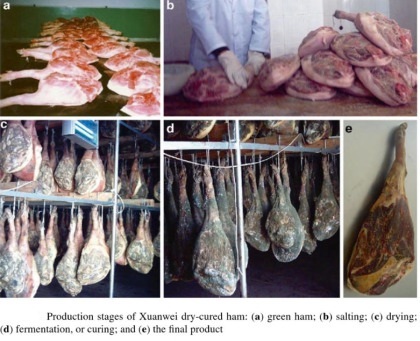
by Kristbergsson and Oliveira, 2016
A simple flow chart is given by Kristbergsson and Oliveira (2016).
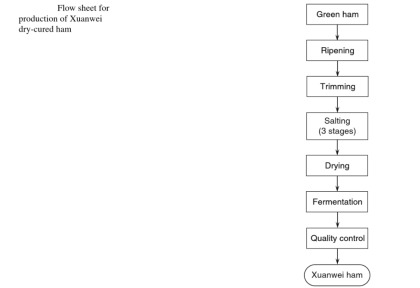
Slaughtering and Trimming

Boiling water and scraping the pig’s hair. Reference: China on the Way.
Traditionally Xuanwei people kill the pigs usually before the last frost. They add boiling water to a wok and scrape the pig’s hair. Some people refer to killing the pig as washing the pig. For villagers, the killing of the pig is a sacred ceremony. (China on the Way)
The hind leg is trimmed into an oval shape in the form of a Chinese musical instrument, the pipa. The legs of small pigs are cut in the form of a leaf. The legs cut off along the last lumbar vertebra. After the blood is pressed out, the meat is held for ripening in a cold room at a temperature of 4 to 8 deg C, relative humidity of 75% for 24 hours. Ripened legs are known as green hams. (Kristbergsson and Oliveira, 2016) This step is an enigma to me since I am not sure what is accomplished in such a short period of time. My guess is that it is not technically ripening, but rather allowing any excess fluids to drain out. I will keep interrogating the processing steps to ensure that my sources have the right information.
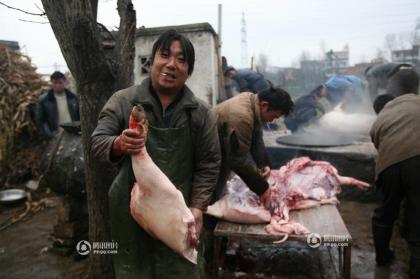
Cutting and trimming the leg: China on the Way.
Salting
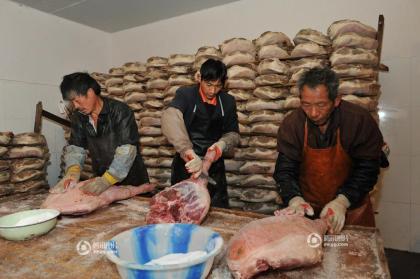
The First Salting: China on the Way.
The green hams are then salted. The salt is a mixture of table salt (25g/kg of leg) and sodium nitrite (0.1g/kg leg). (Kristbergsson and Oliveira, 2016) The inclusion of sodium nitrite is without question a modern development since nitrite curing of meat only became popular after World War I. My instinct tells me that they originally only used salt and later, possibly, sodium nitrate, the production of which has been done for very long in Chinese history.
The salt is rubbed into the hams by hand massaging for around 5 minutes. “The salted hams are then stacked in pallets and held in a cold room at 4 to 8 deg C, 75 to 85% relative humidity for 2 days. Salting procedure is then repeated.” The salt ratios are this time changed to table salt of 30g/kg ham and sodium nitrite is kept at 0.1g/kg leg. The meat is rested for a further 3 days in the chiller after which another salting is done. The ratio of this salting is 15g of table salt per kg of ham and again, sodium nitrite is kept at 0.1g per kg ham. (Kristbergsson and Oliveira, 2016)
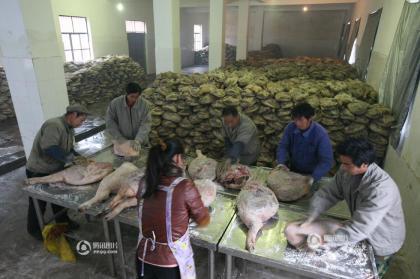
Kneeing the hams as salt is rubbed in by hand: China on the Way.
According to Li Yingqing and Guo Anfei, “traditionally made hams are cured with half the salt used in factories. Instead, they are allowed to dry-cure for at least eight months to about three years, so the meat has time to mellow and mature.” “The longer the ham is cured, the better the quality and the most popular product now is the three-year-old cured ham.”
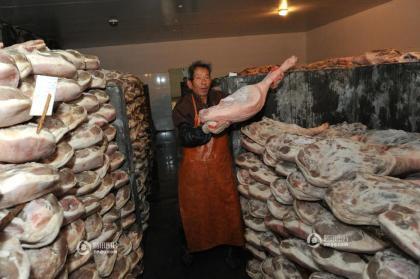
Double Salted Hams: China on the Way.
Drying
The hams are then hung in the drying room with a temperature of 10 to 15 deg C and relative humidity of between 50 and 60%. (Kristbergsson and Oliveira, 2016) Note how the temperature is increased and the relative humidity decreases to facilitate drying from the inside, out.
The excess salt is brushed away and the hams are dried for 40 days. Windows are kept open to facilitate air movement to air drying. Screens are placed in front of openings to prevent flies, other insects and birds from entering. If drying is too fast, a crust will form on the outside of the ham and if it is done too quick, the inside will not be dried and will spoil. If drying is done too long, the meat will be too dry to accommodate the lactic acid bacteria which will be involved in the fermentation process.
Li Yingqing and Guo Anfei reports on the traditional way that drying was done. “If you visit the villages by Nujiang, you may chance upon a strange sight in winter, when the hams are hoisted high on trees so they can catch the best of the drying winds. These trees with hocks of ham hanging from them seem to bear strange fruit indeed.”
Fermentation

Drying and Fermentation: China on the Way.
After drying, the temperature is raised to 25 deg C. Relative humidity is pushed up to 70% and ideal conditions are created for fermentation. This process lasts for 180 days. Apart from creating an ideal condition for microbes, raising the temperature and humidity favours enzymatic activity, which is important in flavour development due to the partial decomposition of lipids (fat) and proteins. (Kristbergsson and Oliveira, 2016)
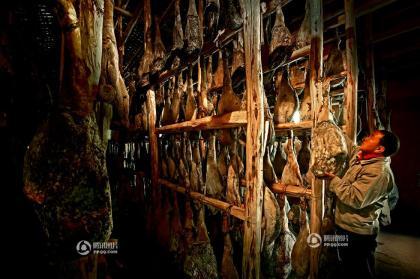
Traditionally, the fermentation process takes more than ten months. When the surface is completely green, the hams are ready: China on the Way.
Aging
“Xuanwei ham is like good wine: the older the better. A ham that’s been aged at least 3 years can be eaten raw like prosciutto di parma.”
Control of Pests
During the curing and drying stages, flies pose a major risk. During fermentation and storage ham moths and mites (eg. tyrophagus putrescentiae) are the major danger. Relative humidity of over 80% attracts flies such as Piophila casei, Dermestes carnivorus beetle and mites. “There has been considerable work done in controlling mite infestation. Microorganisms such as the Streptomyces strain s-368 help prevent and treat mite investigation.” (Kristbergsson and Oliveira, 2016)
Evaluation
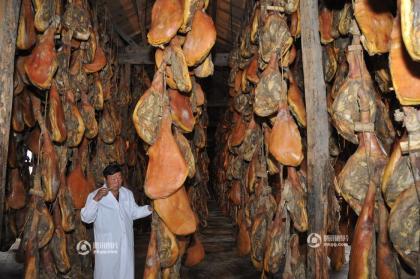
Bone needles or bamboo needles are used to insert it into three specific sites to check the ham. The smell tells the evaluator if the ham is ready: China on the Way.
Xuanwei hams are evaluated by sensory evaluation. The odor is absorbed by a bamboo stick, used for the evaluation. This is the most traditional absorption method to classify different ham grades. For a detailed discussion and evaluation of this method, see Xia, et. al (2017), Categorization of Chinese Dry-Cured Ham Based on Three Sticks Method by Multiple Sensory Techniques
Storage
Storage is done under ambient conditions and the hams can be stored between 2 and 3 years.
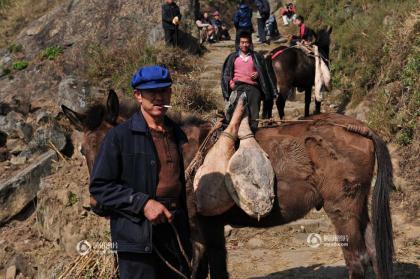
A caravan travelling along an ancient road. Pu Zaiting must have been driving just such a caravan, journeying from north and south: China on the Way.
Physiochemical Indices

by Kristbergsson and Oliveira, 2016
“The physical and chemical properties of dry-cured ham are important determinants of its quality (Jiang et al. 1990 ; Careri et al. 1993 ). The lean portion of Xuanwei ham contains 30.4 % protein, 10.9 % fat, 10.3 % amino acids, 42.2 % moisture, and 8.8 % salt (Jiang et al. 1990 ). The whole ham contains 17.6 % protein, 29.1 % fat, 5.6 % amino acids, 24.8 % moisture, and 3.3 % salt (Jiang et al. 1990 ). Many essential elements are present in the ham as are some vitamins. The ham is particularly rich in vitamin E (45 mg/100 g). The characteristic bright red color of Xuanwei ham is mainly attributed to oxymyoglobin and myoglobin. The flavor and taste are associated with the presence of various amino acids and volatile organic compounds . The volatile substances present in Xuanwei ham have been extensively studied (Qiao and Ma 2004 ; Yao et al. 2004 ). Seventy-five compounds were tentatively identified in the volatile fraction. The compounds identified included hydrocarbons, alcohols, aldehydes, ketones, organic acids, esters, and other unspecified compounds.” (Kristbergsson and Oliveira, 2016)
Microflora
The dominant microorganism on the surface of dry cured hams is mold, which affects quality. During the ripening stage, molds play an important and positive role in flavour and appearance. A study of Iberian dry-cured hams showed that yeasts are predominant during the end of the maturing phase of production whereas Staphylococcus and Micrococcus are absent. This surface yeast population has been shown to be useful for estimating the progress of maturation. Its contribution to curing is suggested to be their proteolytic or lipolytic activity. (Kristbergsson and Oliveira, 2016)
In Xuanwei hams, researchers have shown Streptomyces bacteria to dominate and account for almost half of the Actinomycetes. Aspergilli and Penicillia are common on the surface of Xuanwei hams during June to August. They found 8 species of Aspergillus. A. fumigatus was found to be dominant and accounts for one third of Aspergilli. Generally speaking, a high relative humidity encourages mold development on the surface of the hams. (Kristbergsson and Oliveira, 2016)
The dominant fungi found on Xuanwei hams is yeast. Yeast can be 50% of the total microorganisms found on mature dry-cured hams. Proteolytic and lipolytic activity of yeast is desirable. Towards the end of maturation, yeast dominates on dry-cured hams. (Kristbergsson and Oliveira, 2016)
Which species to be found during the different stages of production depends on temperature and relative humidity. In the Xuanwei region, humidity and temperature are highest during the rainy season. Molds occur almost exclusively on the surface of the hams. Aspergilli and Penicillia occur mostly during May when relative humidity and temperature are high. These fungi peak in July and August. Molds begin to grow in May and are well established by June. Spores are formed in August and September. The quantity of spores falls off gradually in September. (Kristbergsson and Oliveira, 2016)
“The growth of bacteria and Actinomycetes does not seem to be dependent on humidity in the curing room. Levels of bacteria are generally lower than levels of yeast. According to Wang, et al. (2006) yeast on ham multiplies exponentially from the beginning of the salting stage to reach a peak in April, and then the numbers drop and stabilise to around 2 x 107 cfu/g.Yeast levels within the ham show similar variation as the surface yeast. According to Wang et al. (2006) yeast accounts for 60 to 70% of the total microbial population on the surface of the ham. In some cases, no molds have been found growing on the surface of good-quality ham; therefore, some researchers believe that molds do not play a direct role in determining the quality of dry-cured ham, but an opposing view also prevails.” (Kristbergsson and Oliveira, 2016)
“According to the traditional view, high quality Xuanwei ham must have “green growth” (i.e. molds) on it. However, fungi such as Penicillia , Fusarium , and Aspergilli are known to produce mycotoxin in foods such as dry-cured Iberian ham (Núñez et al. 1996 ; Cvetnić and Pepeljnjak 1997 ; Brera et al. 1998 ; Erdogan et al. 2003 ). More than 15 % of the mold strains examined were found to produce mycotoxins in Xuanwei ham (Wang et al. 2006 ). The toxins penetrated to a depth of 0.6 cm in the ham muscle. Because most of the fungi that occur on ham have not been examined for producing mycotoxins , contamination with toxins might be more prevalent than is realized.” (Kristbergsson and Oliveira, 2016)
Feasting
“The ham must be flame burned and washed before eating, in order to remove the rancid taste.” (China on the Way.)
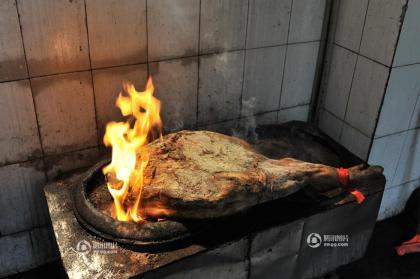
Flame treatment: China on the Way.
There are an infinite variety of ways to serve the ham. It can be steamed, boiled, fried, or used as accessories. Old legs can be eaten raw. When cooking, cook either the whole ham or large cuts on a slow fire or slow boil it to retain the flavour.
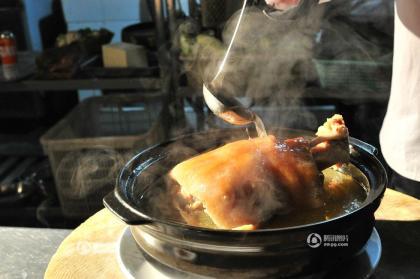
China on the Way.
Further Reading
Traditional Foods, Kristbergsson, K., Oliveira
—————————————————————–
Reference
Adshead, S. A. M.. 1992. Salt and Civilization. Palgrave.
chinadaily.com Updated: June 26, 2019
China on the Way, XuanWei Ham
Flad, R., Zhu, J., Wang, C., Chen, P., von Falkenhausen, L., Sun, Z., & Li, S. (2005). Archaeological and chemical evidence for early salt production in China. Proceedings of the National Academy of Sciences of the United States of America, 102(35), 12618–12622. http://doi.org/10.1073/pnas.0502985102
Huang, Christy. 2015. Old Towns of Yunnan, Heijing.
Kristbergsson, K., Oliveira, J. (Editors). 2016. Traditional Foods: General and Consumer Aspects. Springer.
Mew, T. W., Brar, D. S., Peng, S., Dawe, D., Hardy. B. (Editors). 2003. Rice Science: Innovations and Impact for Livelihood. International Rice Institute (IRRI).
Needham, J., Ping-Yu, H., Gwei-Djen, L.. 1980. Sivin, N.. Science and Civilisation in China: Volume 5, Chemistry and Chemical Technology. Cambridge University Press.
SBS – http://www.sbs.com.au/food/article/2017/04/30/over-1000-years-ham-heres-where-it-all-began
http://www.yunnanadventure.com/index.php/Attraction/show/id/153.html
https://yunnan.chinadaily.com.cn/2012-01/16/content_14500704.htm
http://www.chinaontheway.com/xuanwei-ham/?i=1
Xia, D., Zhang, D. N., Gao, S. T., Cheng, L., Li, N., Zheng, F. P., Liu, Y.. 2017. Categorization of Chinese Dry-Cured Ham Based on Three Sticks Method by Multiple Sensory Techniques Volume 2017, ID 1701756 https://doi.org/10.1155/2017/1701756
Yunnan Xuanwei Ham (宣威火腿/xuān wēi huó tuǐ) Yunnan Xuanwei Ham (宣威火腿/xuān wēi huó tuǐ) Eben van Tonder 10 May 2020 Introduction Yunnan is one of China's premium food regions known for exquisite tastes.
0 notes
Audio
[DL]
zai xue zhong si nue de Fire wu zhi jing de ran shao rang kong qi zheng teng de Higher yan gai bing leng jian ao zhen shi chong xin jiang wo zhan ju yao yan guang mang Shining shen chu yu wang tan lan de mo zhang wo zhi xiang rang ni kan dao Oh heng liang jia wei duo nan de de Chance bie mian qiang pi pei ling jia wo No way Blow up chong po hei an bao wei We glow up duo bu kai de chan mei We drive ’em crazy crazy We do it daily daily shan yao de guang hui ci tou shuang yan de yu mei We be Shinin' shinin' just like a diamond Blindin' blindin' you like a diamond Shinin' shinin' just like a diamond Blindin' blindin' you like a diamond Shinin' shinin' just like a diamond Blindin' blindin' you like a diamond cong bu hui shan duo hou tui bei qian chui bai lian de jiao ao tou ming zhe she chu de zhen gui shi jing xin diao zhuo de yin zhao bie she qiu geng jia wan mei wo hui yong yuan zai ni shen bian pei ni dao tian huang di lao mei you shen me neng zu nao zhong jie fa wei yong da mo shou wei yao xin xian ding wei qing zhuan zhu My way Blow up chong po hun luan bao wei We glow up jian bie huang yan zhen wei We drive ’em crazy crazy We do it daily daily shan yao de guang hui ci tou shuang yan de yu mei We be Shinin' shinin' just like a diamond Blindin' blindin' you like a diamond Shinin' shinin' just like a diamond Blindin' blindin' you like a diamond Oh bie zai chi yi Baby he wo yi qi Baby wo hui zheng ming wo dui ni you duo zhong yao xiang ke shen mi zuan shi hei ye zhong dou shan yao Shine on Shine on hei ye zhong dou shan yao Shine on Shine on na shu guang Only one Shine on Shine on Shine on zhong jie fa wei yong da mo shou wei yao xin xian ding wei qing zhuan zhu My way Blow up chong po hun luan bao wei We glow up jian bie huang yan zhen wei We drive ’em crazy crazy We do it daily daily shan yao de guang hui ci tou shuang yan de yu mei We be Shinin' shinin' just like a diamond Blindin' blindin' you like a diamond Shinin' shinin' just like a diamond Blindin' blindin' you like a diamond Shinin' shinin' just like a diamond
#170718#exo#suho#kai#sehun#baekhyun#d.o#chanyeol#chen#xiumin#m:audio#a:the war#comeback:the war#t:lyrics
3 notes
·
View notes
Video
Learn Chinese and Chinese Culture in stories|Chinese legend |Pan Gu crea...
In Chinese legend, the universe was originally an egg-like chaos. A hero named Pangu struck the chaos with a magic axe,and and separated the sky and earth with his body, that is the origin of the world.
在中国神话中,宇宙最初是一个鸡蛋一样的混沌。一个叫盘古的英雄用一把神奇的斧头劈开了混沌,用身体撑起了天地,这就是世界的起源。
CONTENT
Hen jiu yi qian, yu zhou yi tuan hun dun
很久以前,宇宙一团混沌
Many years ago, the universe was a mass of chaos.
Zai hun dun zhong chen shui zhe yi ge ren
在混沌中沉睡着一个人
In the chaos slept a man
Ta de ming zi jiao pan gu
他的名字叫做盘古
His name is Pangu
You yi tian Pan Gu xing le
有一天盘古醒了
One day ,Pan Gu woke up
Ta de yan qian yi pian qi hei
他的眼前一片漆黑
The darkness all around him
Zhe shi tian shang diao xia yi ba qi guai de fu tou
这时天上掉下一把样子奇怪的斧头
A strange-looking axe fell from the universe at that time
Pan Gu lun qi da fu tou
盘古抡起大斧头
Pan Gu swung the axe
Chao yan qian de hei an meng pi guo qu
朝眼前的黑暗猛劈过去
Struck the darkness before him
Zhi ting jian yi sheng ju xiang
只听见一声巨响
Only heard a loud noise
Hun dun jian jian fen kai
混沌渐渐分开
The chaos gradually separated
Pan gu yong jin suo you li qi cheng kai hun dun
盘古用尽所有力气撑开混沌
Pangu uses all his strength to keep the chaos open
Qing er qing de dong xi huan man shang sheng
轻而清的东西缓慢上升
The light and clear things slowly risen
Bian cheng le tian
变成了天
Became the sky.
Tian he di zhu jian cheng xing
天和地逐渐成形
the sky and the earth gradually formed
Dan shi Pan gu que lei dao le
但是盘古却累倒了
But Pangu was exhausted.
Ta hu chu de qi xi bian cheng le feng he yun
他呼出的气息变成了风和云
His breath turned into wind and clouds
Ta fa chu de sheng yin bian cheng le lei dian
他发出的声音变成了雷电
His sound turned into thunder and lightning
Ta de shuang yan bian cheng le tai yang he yve liang
他的双眼变成了太阳和月亮。
His eyes became the sun and the moon.
Ta de ji fu bian cheng le shang chuan da di
他的肌肤变成了山川大地
His skin turned into mountains and fields
Ta de xue ye bian cheng le jiang he
他的血液变成了江河
His blood turned into rivers
Ta de han shui bian cheng le yu lu
他的汗水变成了雨露
His sweat turned into rain and dew
KEYPOINTS
Tiān
天 The Sky, heaven ,day
Dì
地 The earth ,land ,soil ,fields
Pán Gǔ
盘 古 The creator of world in Chinese legend
Kāi tiān pì dì
开 天 辟 地 Separated the sky and earth created the world
Now It means since the dawn or beginning of history;
We hope to help you understand Chinese and Chinese culture in stories. Also, please LIKE, SHARE and COMMENT on our videos if you like. Thanks!
If you want more help in learning Chinese and try a private free class, you can
STEP1: visit OFFICIAL WEB: www.chinesetong.com
STEP2: REGIST with your email address
STEP3: MAKE AN APPOINTMENT to try a a FREE CLASS.
KEYWORDS 【#Learn Chinese #apprendre le chinois #Aprender chino #تعلم اللغة الصينية #중국어를 배우다 #belajar bahasa Cina #учить китайский #Chinesisch lernen #matuto ng Tsino #discite Sinica #Aprenda chinês #учим кинески #học tiếng Trung Quốc #impara cinese #למד סינית #вивчити китайську #فرهنگ و آداب و رسوم چینی #Çin kültürü ve gelenekleri #เรียนภาษาจีน #Chinese culture and customs # الثقافة والعادات الصينية # فرهنگ و آداب و رسوم چینی #Chinesische Kultur und Bräuche #Китайская культура и обычаи #Culture et coutumes chinoises #Kulturang Tsino atkaugalian #တရုတ်ယဉ်ကျေးမှုနှင့်ဓလေ့ထုံးတမ်းများ#Cultura e costumes chineses #Кинеска култура и обичаји #Çin kültürü ve gelenekleri #Китайська культура та звичаї #Cultura y costumbres chinas # Văn hóa và phong tục Trung Quốc #Cultura e costumi cinesi #วัฒนธรรมและประเพณีจีน #Pin yin #Mandarin #Chinese history #Chinese learning 】
0 notes
Text

"really?" the commander grins, remembering days where he too, would spend his days covered in paint and charcoal. "well then perhaps your skirt does not need my apology but your's." it's a genuine jest, noticeable unlike the sharpness of his usual sarcasm. he finds himself bending down next to her. "if you wish to see flowers far more beautiful, there is a private courtyard on the opposite side of the fort. it is only trafficked by staff and military, you'd be safe to sketch where-ever beauty took you."

" ah, it'll be okay. it's not the first time i've ruined a skirt with charcoal, " kai-ming admitted sheepishly. her . . . adventures past the palace walls often left her with stained shoes and skirts, but those were her common clothes and they were easy for her to toss away without anyone batting an eye.
at the question, the princess looked down at the flower and gestured to it. " this flower ! it's beautiful, and i wanted to preserve it's memory for when i go back home. " she said with a smile, " i often connect places and people with memories of the flowers i saw in the moment, so . . . i like to remember the flowers, as well. they deserve to be remembered, don't you think ? "

21 notes
·
View notes
Text

with legs drawn to his chest, chin rests upon knee. abdullah's eyes scan the courtyard from atop a tower, off-duty yet settled by the view of delhi's skyline from the towers that he frequented. it was mid-day, the sun shone brightly in the cloudless skies; the perfect day to watch people move about the grounds without needing to be anybody but themselves. cailean being in the palace had thrown everything off-kilter despite its welcome. yet, with interrogations under way, he wasn't sure how much longer he could stay. out of their pocket, they take a drawn picture of a child, thumbing over the intricate lines of lead-traced features and red-tinted curls. they had drawn a lot as a child, perhaps more than they should've - now, they wouldn't remember the skill even if it was innate. it's why she catches his attention. curiosity takes them down to the courtyard, his eyes spotting the princess and deciding to approach, a wince appears on his features. "please, no apologies are necessary on your part. on mine, however, i believe they are owed to your cloth." he points. "- what were you sketching?"
° • — open starter ° • — four days after the interviews

she hadn't quite realized she was stopped on the main pathway, in the way of those walking — all kai-ming saw was a lovely flower, bloomed towards the sun. the princess had knelt down, crouched in front of the bloom as she detached the small sketchbook she kept attached to her belt. she had begun sketching the flower, fascinated by it's petals. kai-ming noted that she would have to write down the colors, for she planned to add some to the sketch upon returning to her chambers.
it was when she heard footsteps come closer, she realized her mistake. " oh, excuse me ! i'm terribly sorry, i didn't realize . . " the princess shot up in a panic, without sparing as much as a single thought to put anything in her hands away — she smudged the charcoal all over the pale pink skirt she wore. a soft, but exasperated sigh came from her.
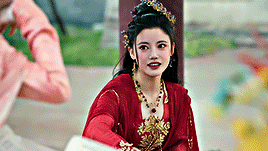
21 notes
·
View notes